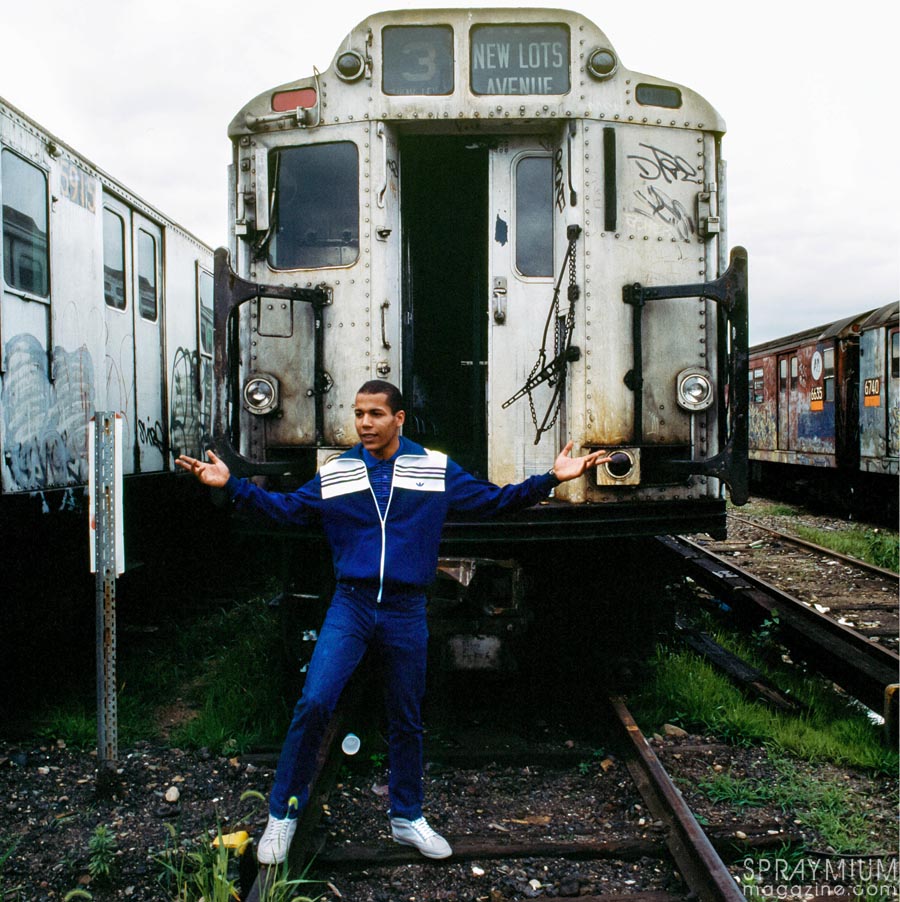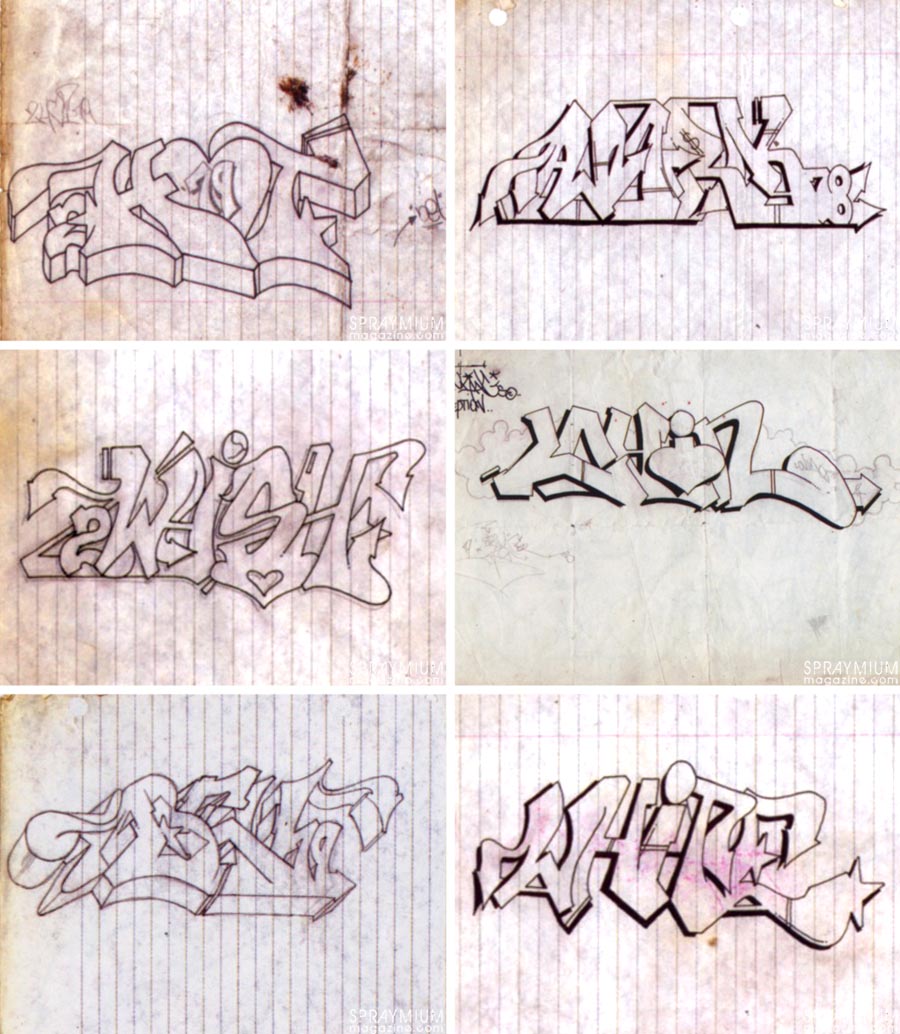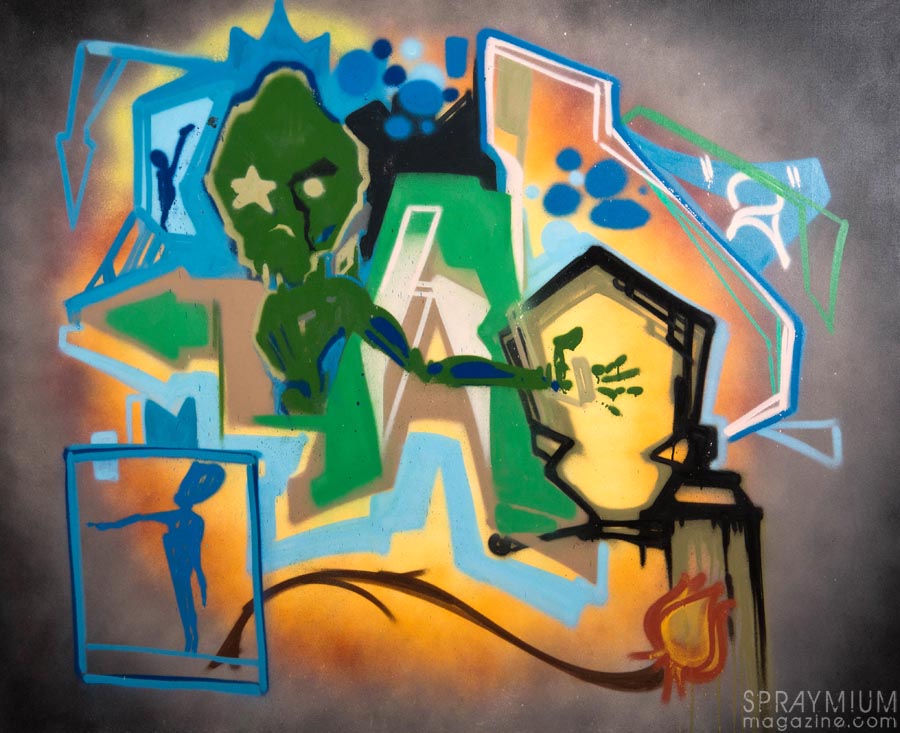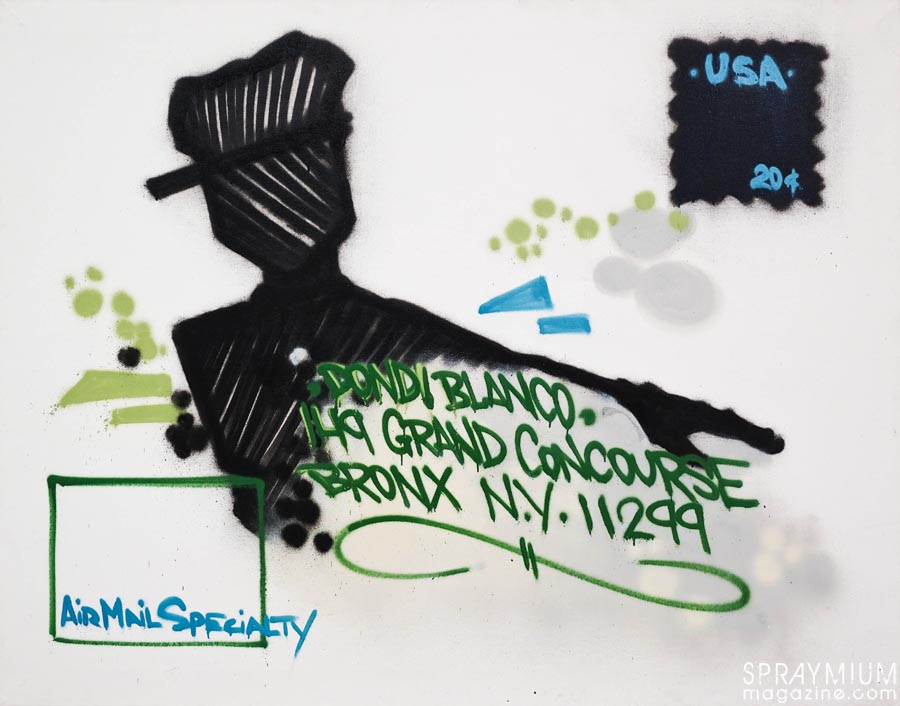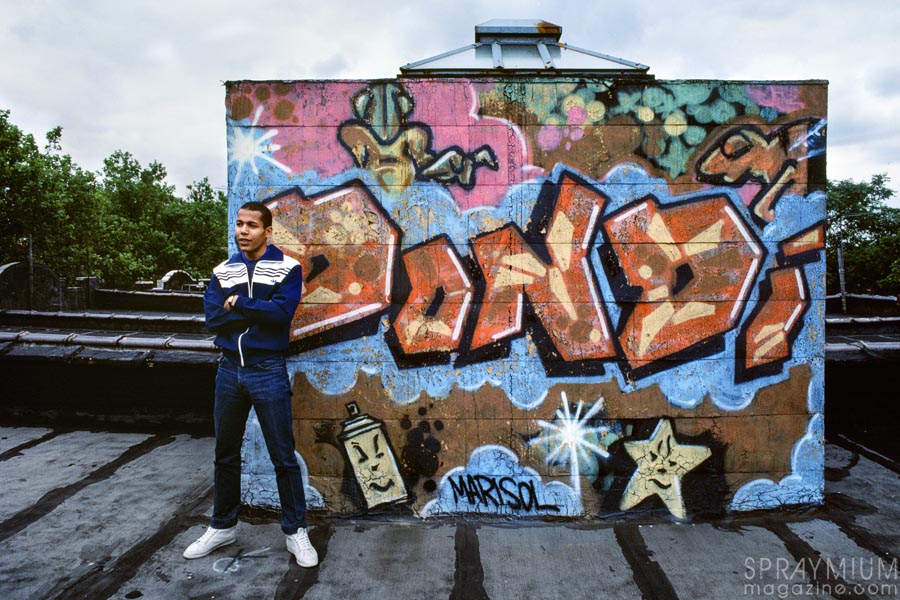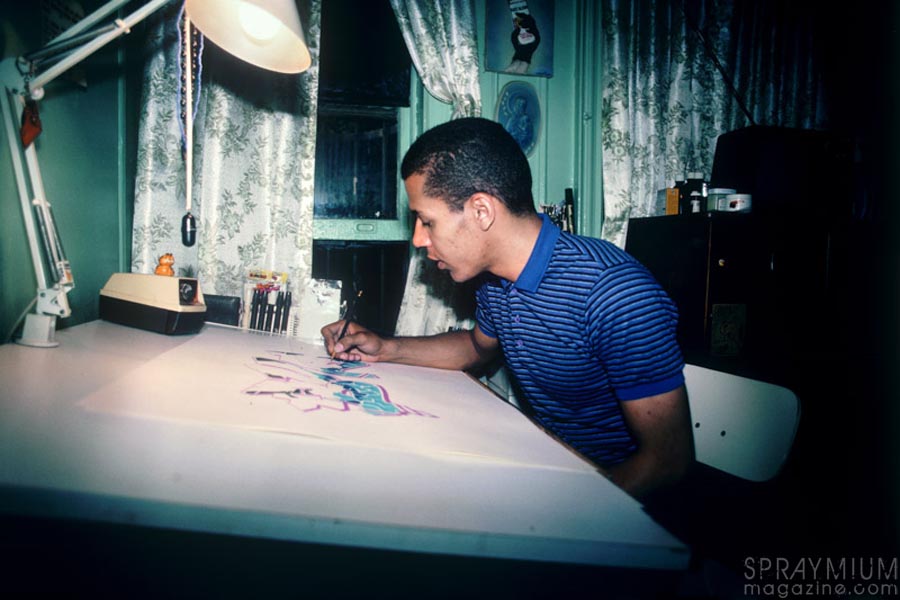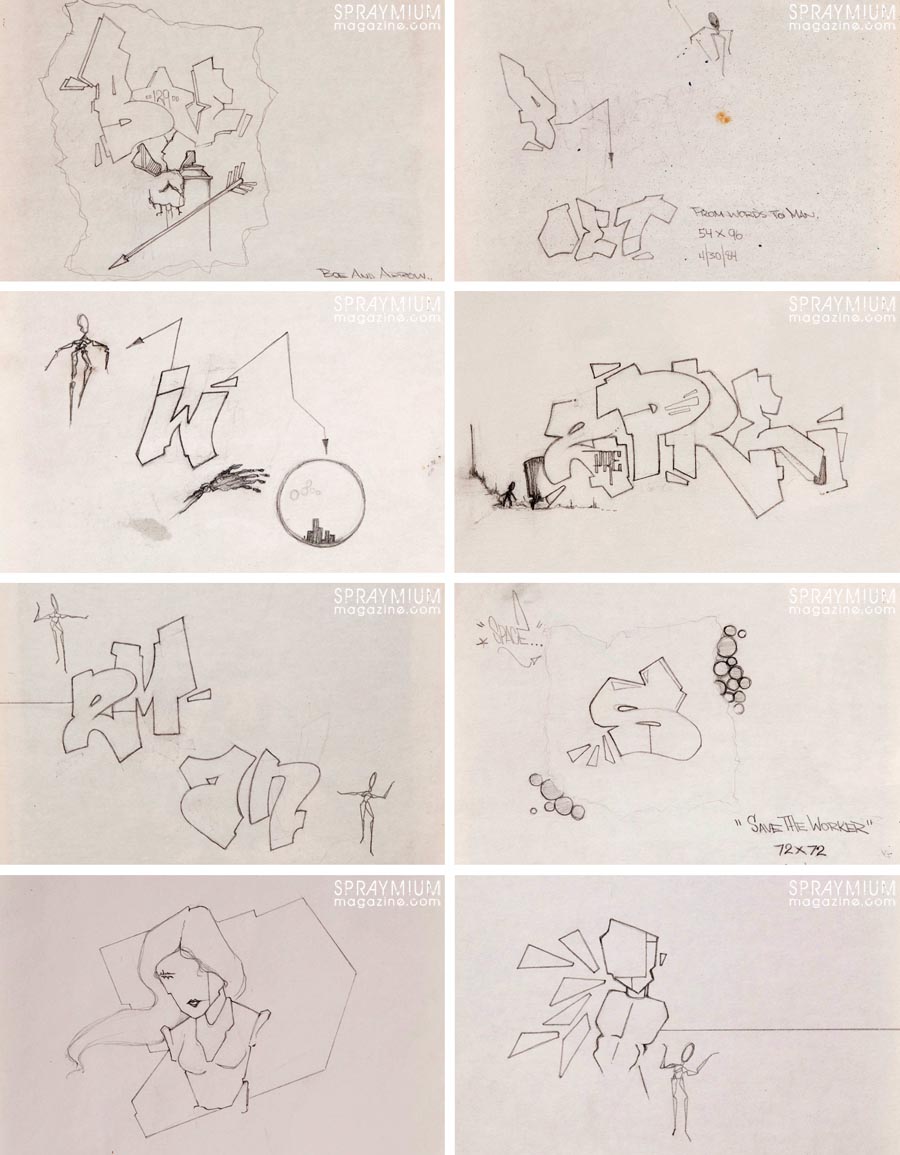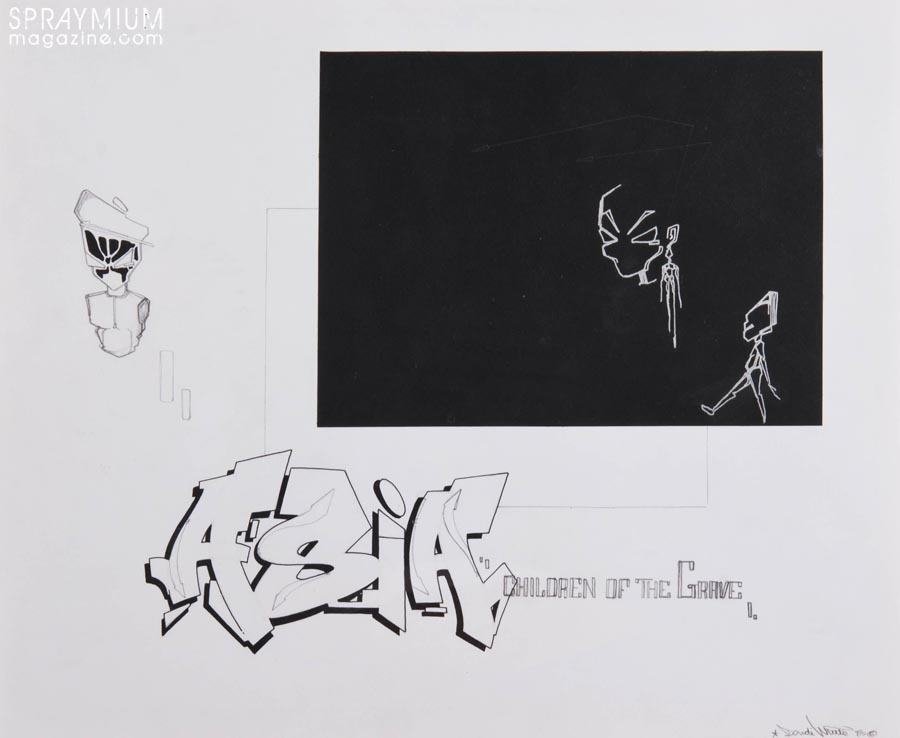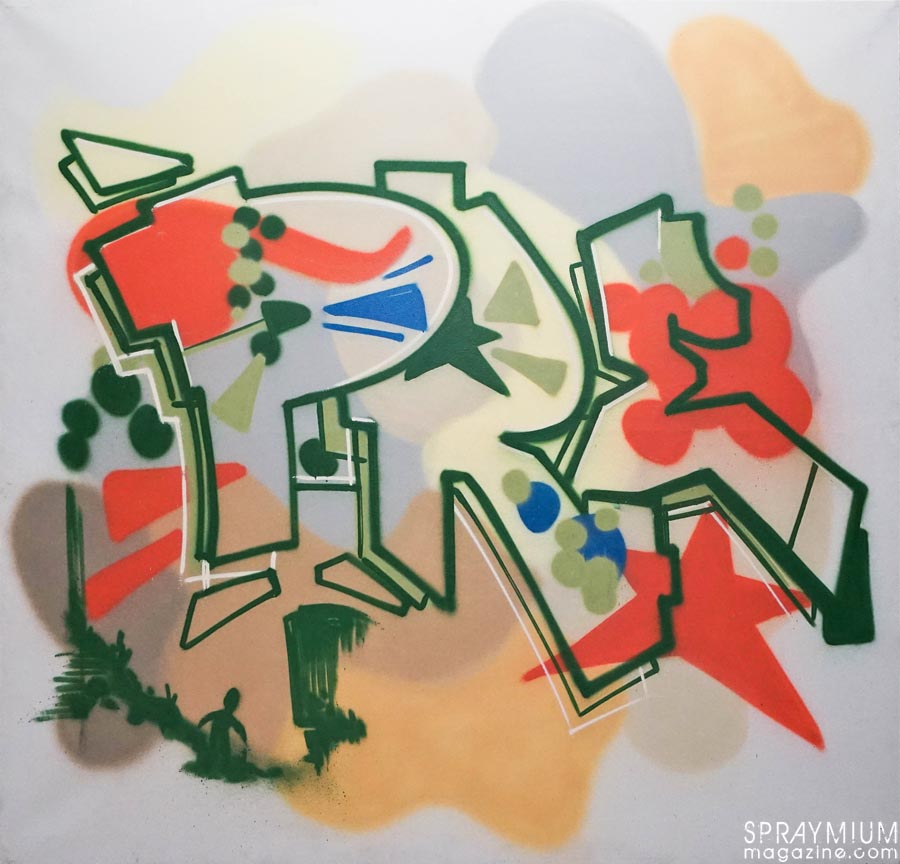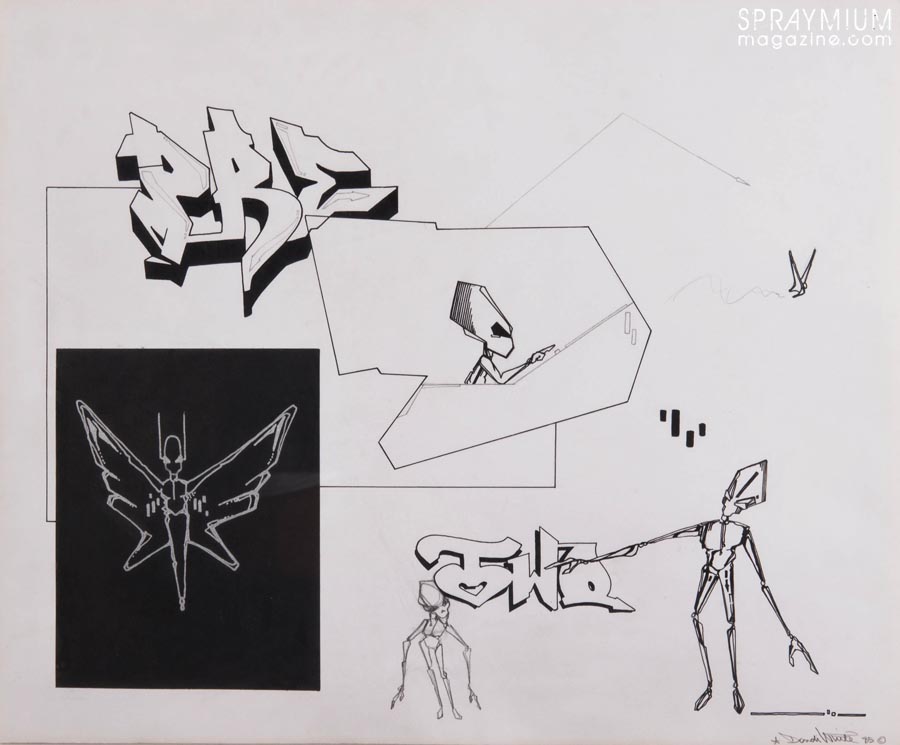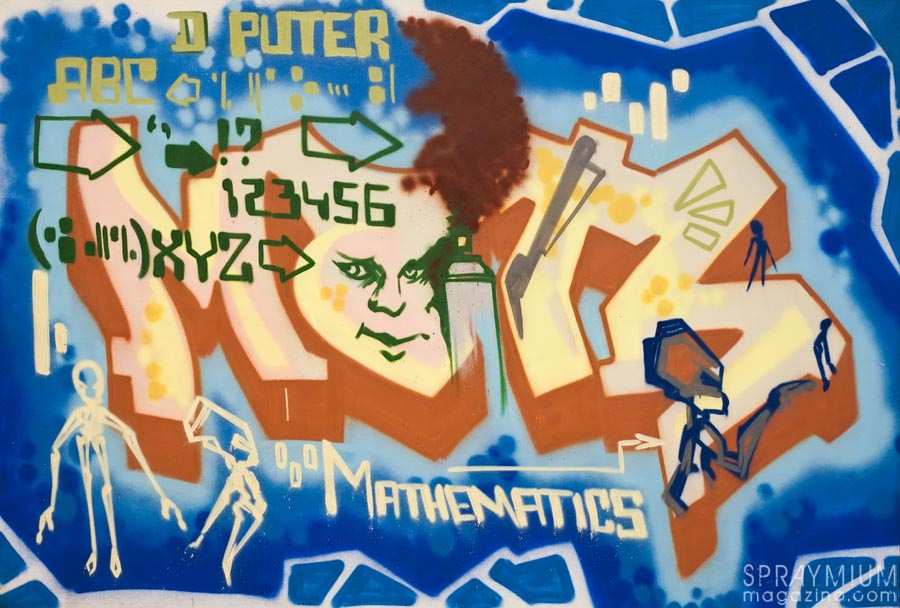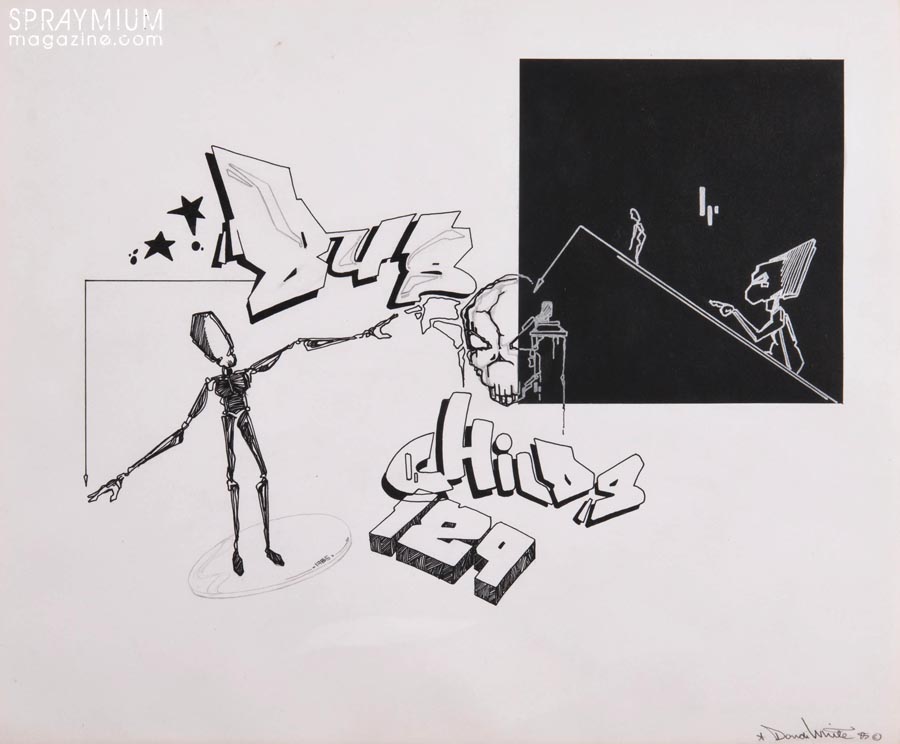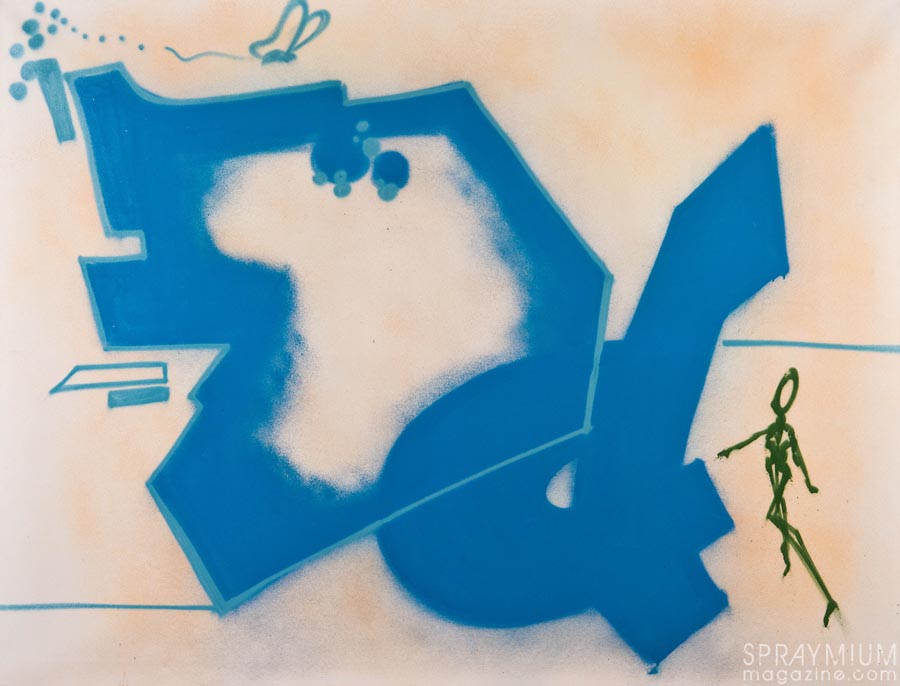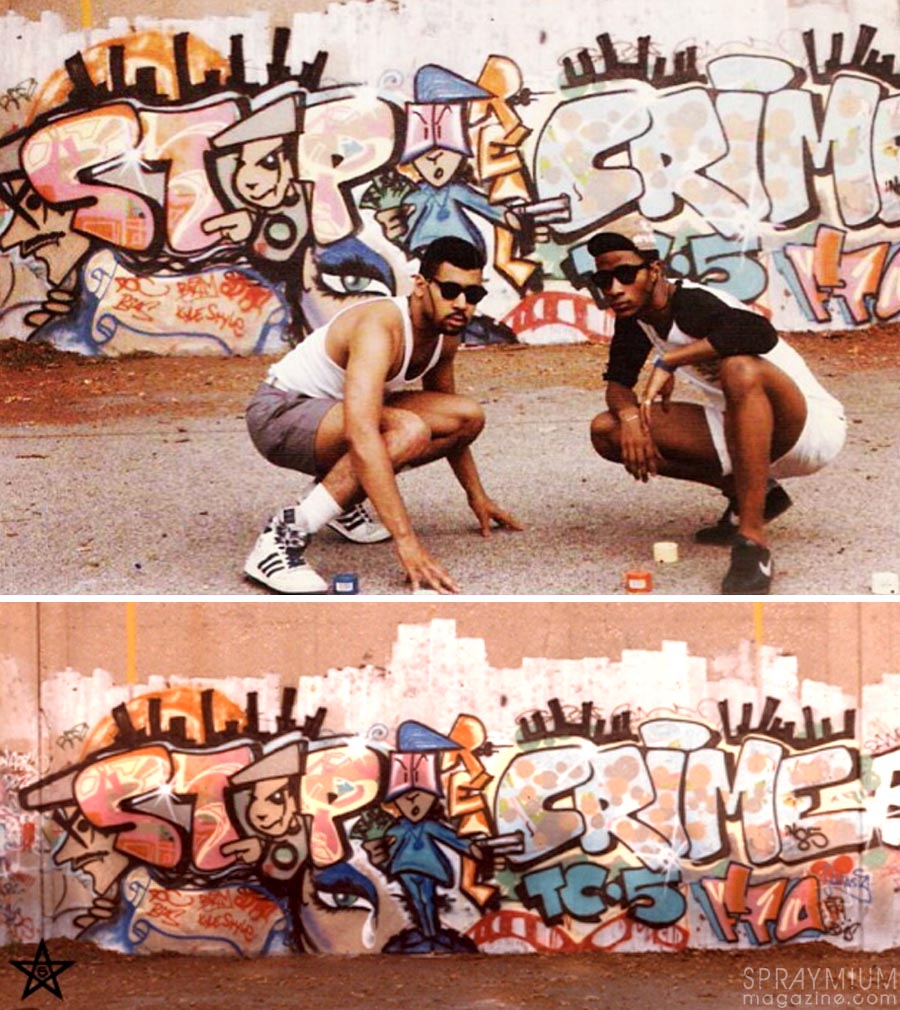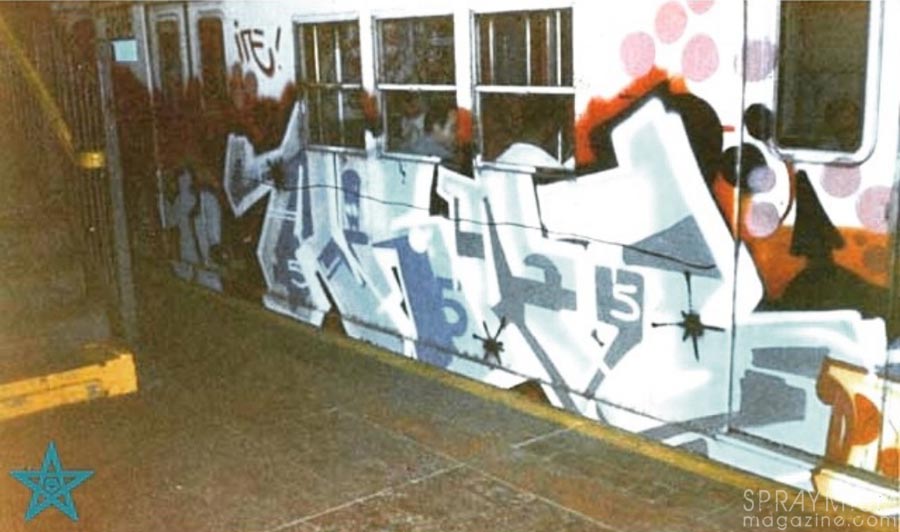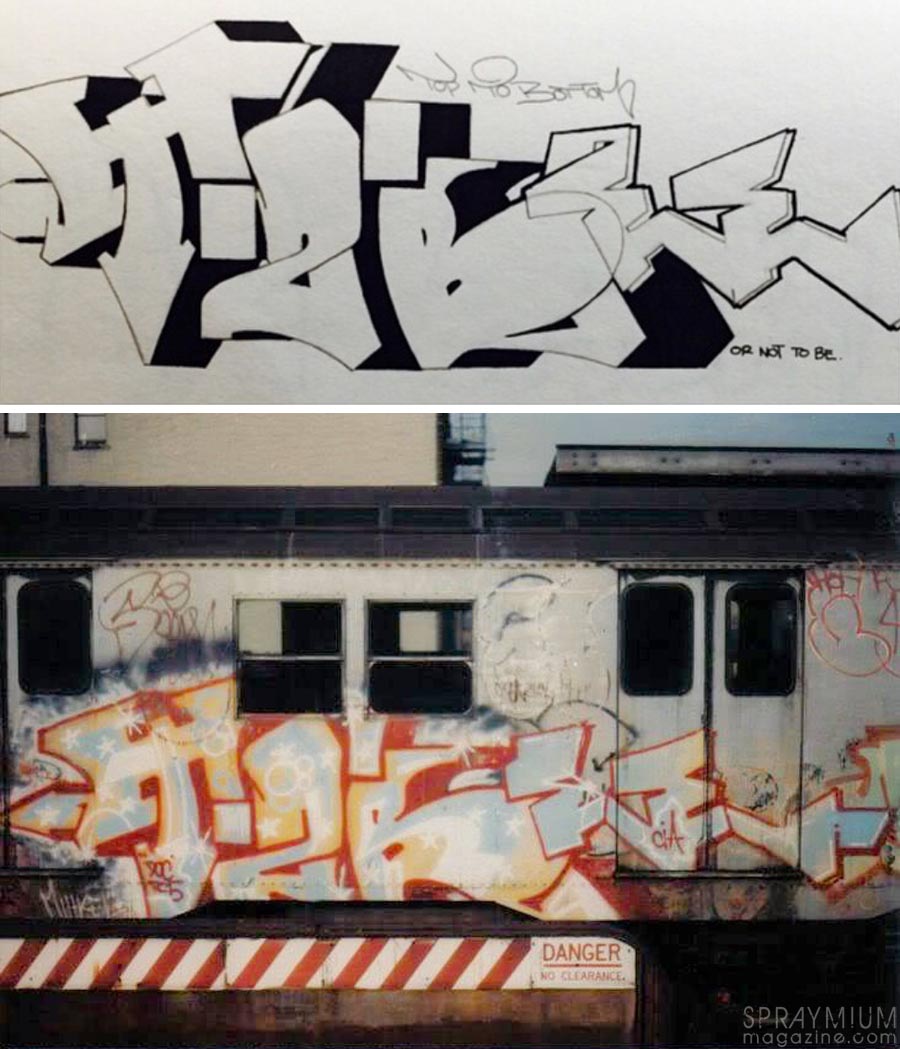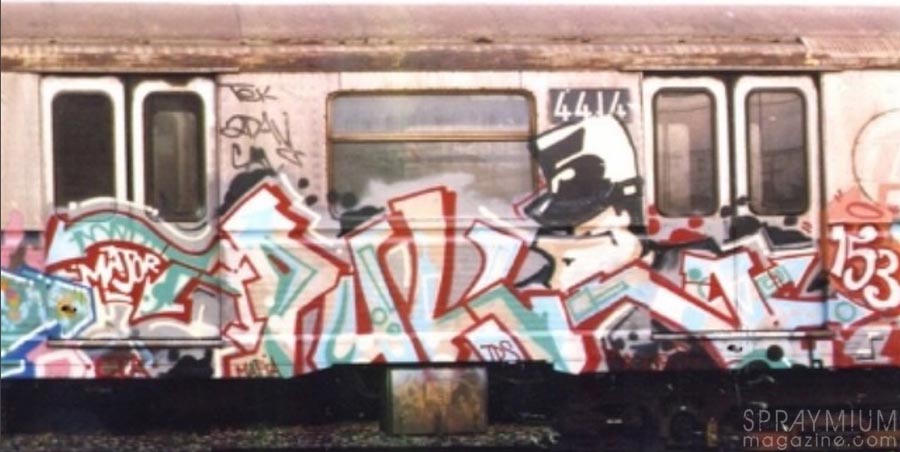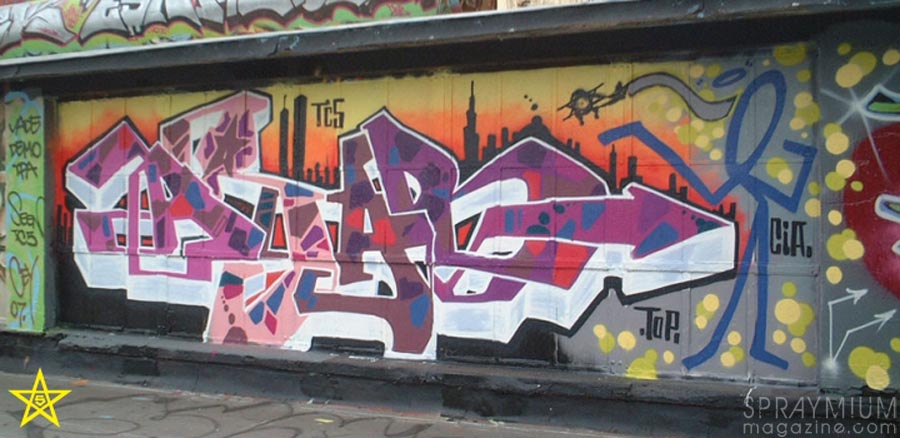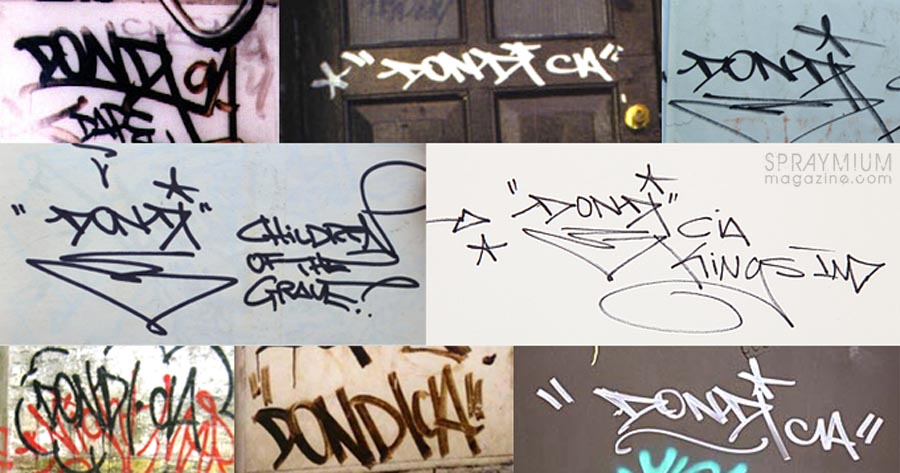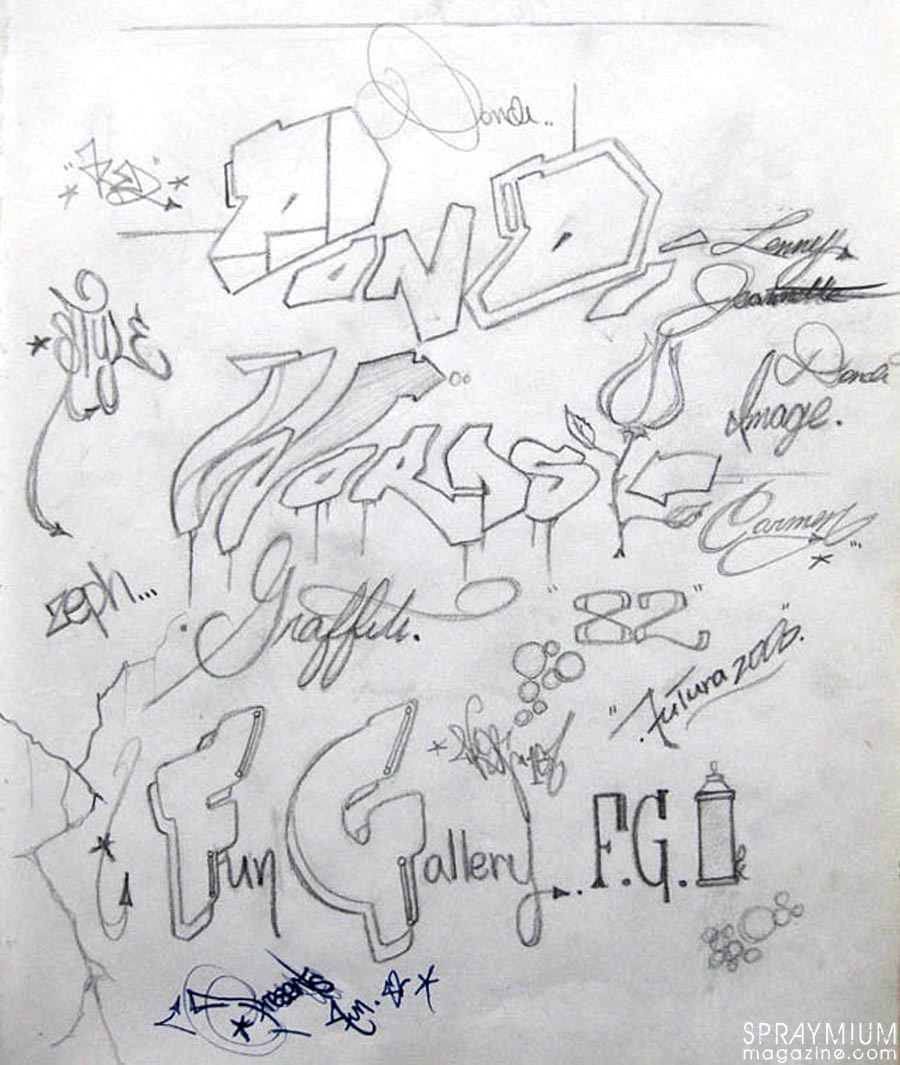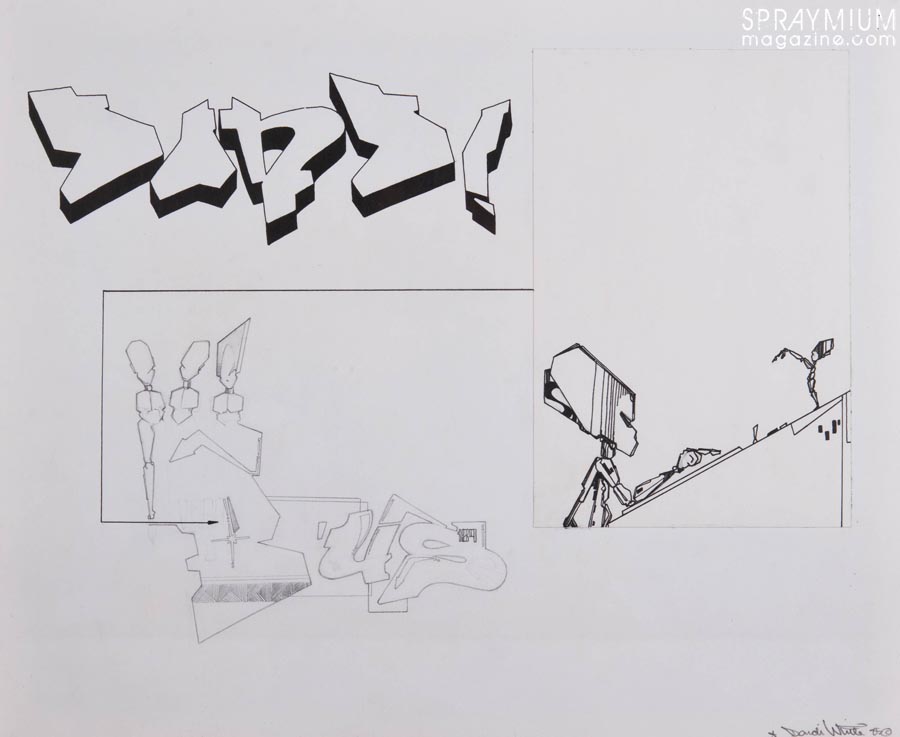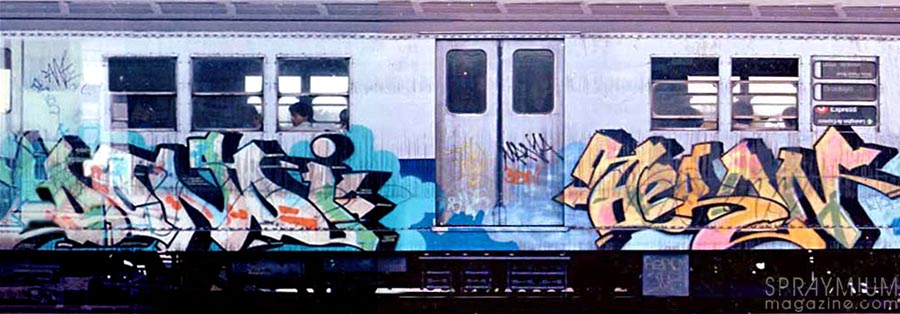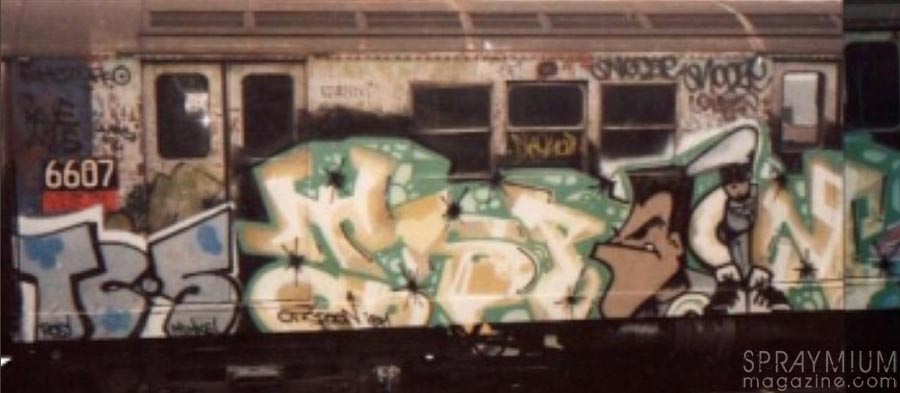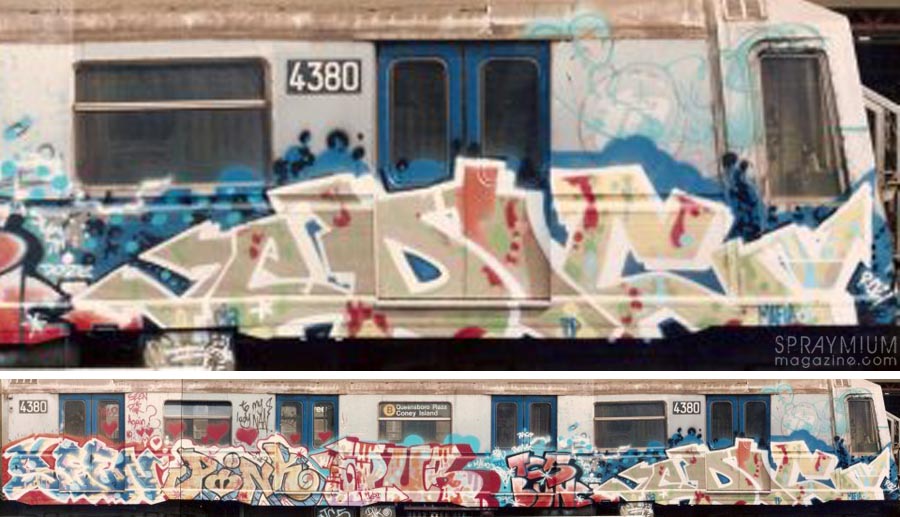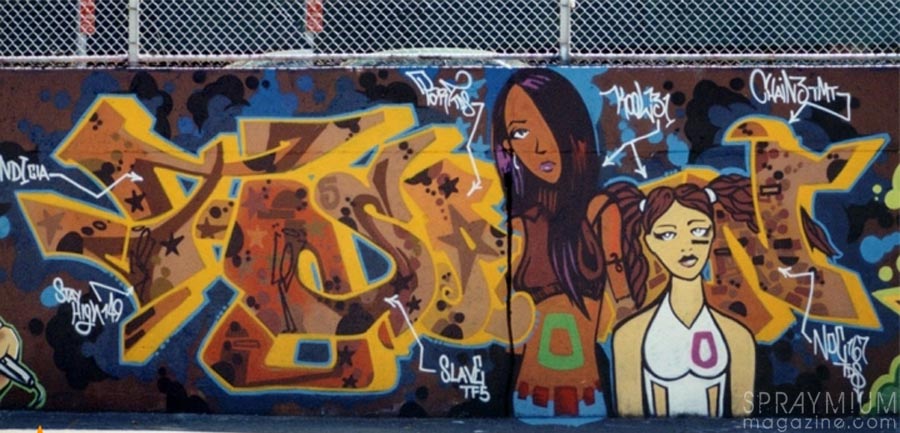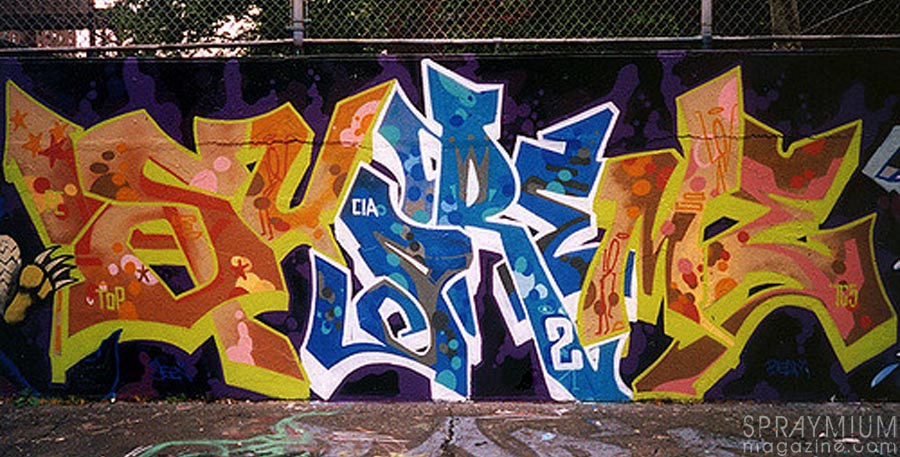Il y a vingt ans, le graffiti perdait l’un de ses généraux : Donald White, plus connu sous le nom de Dondi. Retour sur la trajectoire d’un prodige, qui a durablement marqué de son empreinte la scène graffiti et post-graffiti.
Cinq block-letters inclinées, impeccables, comme jetées par une main grande ouverte à la surface d’un train. Cinq lettres rondes, cursives, encadrées par des personnages tout droit sortis des comics de Vaughn Bode. À l’évocation de Dondi, les premières images qui viennent à l’esprit sont les whole-cars de la série « Children of the grave » – hommage au heavy metal de Black Sabbath en pleine poussée hip-hop. Figurant en bonne place dans le livre Subway Art de Henry Chalfant et Martha Cooper, avec les portraits de l’artiste en action, leurs reproductions photographiques ont fait le tour du monde et, depuis la parution de l’ouvrage en 1984, leur virtuosité n’a cessé d’inspirer des générations de graffeurs. « Avec Subway Art, ses graffs sont devenus iconiques, confirme l’artiste RCF1, qui a interviewé Dondi en 1992 à l’occasion de l’exposition Coming from the Subway au Groningen Museum. Combien de gamins ont recopié ses dessins pour comprendre comment s’organisait l’enchaînement des lettres ? On a tous pioché dans un de ses graffs, vu en photo. »
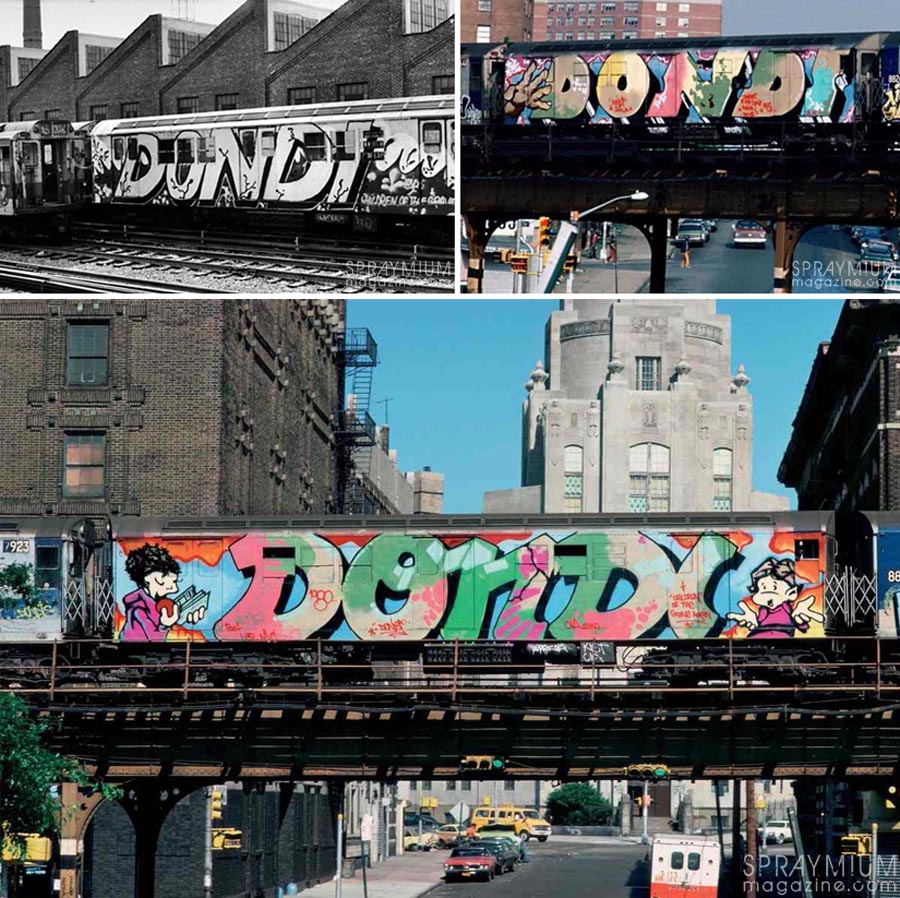
« Children of the Grave » part.1, 2 & 3 – NYC 1978-1980 – Photos : Francisco Reyes & Martha Cooper – Dondi a peint trois whole-cars intitulés « Children of the Grave ». Peu de gens se souviennent du premier, peint en 1978. Le second et le troisième en revanche, sont considérées comme les pièces les plus connues et iconiques du graffiti new-yorkais.
À elles seules, les pièces magistrales de « Children of the Grave » ne sauraient pourtant expliquer ce qui valut à Dondi le titre envié de « style master general » – de maître du style. Et c’est peut-être au-delà des quelques clichés archi-connus par lequel l’artiste a conquis la planète qu’il faut chercher la clé de sa légende. Car derrière Dondi, surnom affectueux donné dès l’enfance par ses frères, se pressent une foule de blazes. L’artiste de Brooklyn devient tour à tour Bus, Pre, Asia, White, Roll, Pose…

Kel, Ream (Noc167), Dondi, Bev (Dondi) – NYC 1978 – Photo : Dondi – « Bev, c’était la copine de Dondi. Elle restait à la maison, ne se souciait pas que l’on parte peindre toute la nuit, mais s’assurait toujours que l’on pose son nom. » (Kel)

Pose (Dondi), Ched (Med167), Solid (Fuzz) – NYC 1979 – Photo : Henry Chalfant – « Fuzz, qui était le roi du vol à l’étalage, nous a fourni la plupart des bombes pour cette session. » (Spar)

Pre2 (Dondi), Kid, Duro – NYC 1979 – Photo : Dondi – « On s’est fait courser par des travailleurs cette nuit là. Dr.Pepper est rentré chez lui. Il avait apporté la peinture alors, quand on est retourné dans le dépôt pour finir nos pièces, on lui a fait un top-to-bottom Code sur un autre wagon. » (Duro)
Cette profusion n’est pas seulement une manière de brouiller les pistes pour se mettre à couvert de la police, ni d’harmoniser son nom avec celui des compagnons de virées. Varier les pseudonymes lui permet surtout d’explorer toutes les potentialités de l’alphabet, et de pousser encore plus loin la maîtrise du wildstyle. Le critique d’art et curateur new-yorkais Carlo McCormick rapporte ainsi sa surprise en découvrant, dans les archives d’Henry Chalfant, que tous ces noms déclinés sur les trains new-yorkais étaient en fait de la main de Dondi : « Il lui arrivait de n’employer un nom qu’une seule fois, rapporte-t-il, juste dans le but d’expérimenter. Alors que le graffiti s’apparente souvent à une sorte de publicité, lui créait de nouveaux pseudonymes dans une quête permanente de style. »
Pour DOC, membre du crew TC5 et disciple de Dondi, la démarche est caractéristique des « maîtres » du writing : « Tout writer soucieux de maîtriser la création de lettrages doit être capable de dessiner à la perfection chaque lettre de l’alphabet », note-t-il. Chez Dondi, cette quête procède d’une attention précise, exigeante, à la dynamique des lettres et de leur enchaînement. « Mon idée, mon truc concernant le style, était de donner une consistance aux lettres, de maintenir leur flow, expliquait-il à Zephyr dans une interview de 1995, reproduite dans la monographie Style Master General. Quand je regardais certaines pièces, je cherchais la faille. Leur contour, leurs couleurs, n’avaient aucune importance. Si la lettre faiblissait d’une manière ou d’une autre, alors toute la pièce était ratée. » Une approche que DOC définit en ces termes : « On peut qualifier de mécanique le style de Dondi. Il obéit aux lois de la physique et de l’ingénierie. » Dans ses graffs, s’affirme aussi la pleine maîtrise de la bombe aérosol : « Quand on découvre le graffiti, le premier challenge est de contrôler l’outil (qui n’est pas destiné aux Beaux-arts), et de ne pas faire de coulures, rappelle RCF1. Chez Dondi, on trouve un côté « enfant propre » : le rendu est soigné, maîtrisé, et il y a la virtuosité du dessin des lettres. »

Dondi CIA, Kel, FUNCITY – NYC 1978 – Photo : Mirame – « Le code couleur de ce wagon est dingue. Dondi devait être capable de prédire l’avenir car ce wagon précède la Fun Gallery de quelques années. » (Zephyr)

Bus (Dondi), Boy5 (Noc167) – NYC 1980 – Photo : Henry Chalfant – « Ce wagon a été peint dans le tunnel Utica. Slave a dessiné le Bus, puis Dondi l’a modifié. Même Dondi a admit que Noc l’avait fumé sur ce coup là. La plupart des bombes pour ce wagon proviennent d’un gros vol à l’étalage réalisé par Noc et moi-même au Woolworth de la 23ème rue. On a brisé le cadenas du présentoir et mis toutes les bombes dans deux grosses valises à roulettes. Puis on s’est tranquillement dirigés vers la sortie qui donnait sur la station de métro. C’était cool. On avait de la peinture pour tout l’hiver. » (Zephyr)

Blue (Rasta), 3rd Rail (Dondi), Zephyr – NYC 1980 – Photo : Henry Chalfant – « La nuit de Noël 1980. Il faisait vraiment froid. On était supposés peindre dans le tunnel No.1 mais il y avait trop d’activité alors on a fini dans le dépôt No.3. Lorsque l’on a commencé à peindre la partie supérieure du wagon, des travailleurs ont surgi et on a dû s’enfuir. Heureusement, nos pièces étaient déjà finies. J’ai inscrit au-dessus de ma pièce : On voulait se faire un Noël mortel, mais le dépôt n’est pas tranquille ce soir. »

2Many (Dondi), Kel – NYC 1979 – Photo : Henry Chalfant – « J’aime le N et aussi le Y car il ressemble à un X. Cette pièce est particulièrement dynamique. Même lorsque le train était à l’arrêt, la pièce paraissait en mouvement. » (Doc)
Du reste, cette exigence déborde largement le cadre du graffiti : elle éclate aussi dans les toiles, dessins et collages auxquels l’artiste se consacre à partir des années 1980. « Pour moi, c’est celui qui a le mieux compris le passage de la rue à la toile, explique la galeriste Valériane Mondot. Il a une sacrée patte, et une sacrée conscience de ce qu’était une production d’atelier. Je me pose la question de savoir ce qu’il serait devenu aujourd’hui. » De fait, sans verser dans l’abstraction comme Futura, ni dans les échappées fantasques d’un Rammellzee, Dondi a d’emblée créé un style personnel, où le lettrage, souvent esquissé dans une palette sobre, voire sombre, se mêle à une série de symboles – crânes, silhouettes, inscriptions latines, timbres, etc… – chargés de son histoire et de ses obsessions. « Il avait une conscience instinctive de la peinture, note RCF1. Il a eu très vite l’intuition qu’il ne fallait pas refaire un graff sur toile. Il avait compris les enjeux de la composition, et percevait que l’énergie du graffiti est dans la bombe aérosol – contrairement à d’autres, qui peignaient leurs toiles au pinceau. »
Comme souvent, la biographie et la personnalité de l’artiste expliquent son obstination à se frayer un chemin bien à lui entre les codes du writing et les attentes des galeristes. Né en 1961 à Manhattan d’une union mixte (sa mère est d’origine italienne et son père est afro-américain), Donald White est le dernier d’une fratrie de cinq garçons. « Dondi était calme et introverti, rapporte son frère Michael. Le cadet observait ses frères ainés pour essayer de ne pas reproduire leurs erreurs. » Il grandit comme les gosses de son âge, élève des pigeons, joue au Ringolevio (un jeu de rue alors classique à Brooklyn), fait du vélo. Seule originalité : il fréquente une école catholique, où son père suppose que l’éducation est de meilleure qualité. L’expérience, qu’il décrit comme heureuse, lui inspirera certains leitmotivs de ses toiles (la vanité, l’inscription « Anno Domini »), et sans doute aussi quelques traits de comportement – dont sa rigueur quasi monastique et une discrétion chevillée au corps. « Il était très timide, se souvient la photographe Sophie Bramly, qui l’a côtoyé au début des années 1980 à New-York, avant de jouer un rôle actif dans la diffusion en Europe de la culture hip-hop. C’était le bon garçon de sa maman qui travaille bien dans sa chambre. Il n’était pas flamboyant comme Zephyr, Futura ou Fab5Freddy. » Si ses incursions dans les dépôts de train et ses audaces stylistiques ne venaient contredire une telle image, Dondi passerait presque pour une nature timorée, pas vraiment taillée pour l’univers viril, voire violent, du graffiti. « Il parlait doucement, et il était du genre discret, mais il y avait un penseur derrière cette image, et on sentait qu’il était à la hauteur. » rapporte Mark Bode, artiste et fils du dessinateur Vaughn Bode. « Il était en quête de vérité », surenchérit Patti Astor, qui l’a exposé en 1982 à la Fun gallery.
Du reste, sa personnalité lui a peut-être évité le pire. Dans les années 1970, la crise économique signe le déclin de Brooklyn, et l’apparition des gangs. De son aveu, Dondi se frotte un temps à l’un d’entre eux, The Crazy Homicides. C’est d’ailleurs à leur manie d’écrire sur les murs qu’il doit ses plus anciens souvenirs de graffitis : « J’ai commencé le graffiti par moi-même, parce qu’en allant dans différents quartiers, je regardais toujours les murs pour voir quel gang tenait le quartier, raconte-t-il. Ça a dû commencer comme ça… » Ses premiers pas dans le writing, au mitan des années 1970, sont aussi le fruit de quelques rencontres, dont celle avec Duro, qui devient son meilleur ami et l’un de ses plus zélés compagnons de route. Avec lui, Dondi s’agrège en 1977 au TOP crew (The Odd Partners), passé maître du throw-up sur les trains de la BMT (Brooklyn Manhattan transit), et y affiche d’abord sa prédilection pour les tags à l’intérieur des trains. Un an plus tard, il fonde son propre crew, CIA (Crazy Insides Artists). À l’époque, les bases du writing sont posées. Les secondes et troisièmes générations de writers s’emploient alors à sublimer ce que leurs aînés ont inventé. À force de passer des heures à façonner ses lettres dans ses sketchbooks et de repousser les limites du style sous les fenêtres des trains, Dondi se forge une réputation de cartonneur. Puis viennent les premiers whole-cars (graffiti couvrant la surface entière d’un wagon, NDLR) : « J’ai fait des whole-cars parce que c’était fun, raconte-t-il. C’était l’étape suivante pour moi. (…) Quand tu as une mentalité de cartonneur, tu fais des pièces de plus en plus grandes, tu développes ton style, puis tu commences à plier les lettres, à jeter des flèches, à faire du wildstyle, et vient le moment où c’est la seule chose qui te reste à faire. »

Bus (Dondi), Eric (Deal) – NYC 1980 – Photo : Henry Chalfant – « Cette pièce est intéressante car Dondi a délibérément abandonné les effets de style et les flèches pour montrer son lettrage dans sa forme la plus basique. » (Daze)

Dream, Bus (Dondi) – NYC 1980 – Photo : Martha Cooper – « Dondi faisait ces blockbusters en chrome lorsqu’il lui restait de la peinture. Il n’aimait pas quitter le dépôt avec des bombes. Ces pièces en top-to-bottom argentés t’avertissaient qu’il y avait un wild-style de l’autre côté du wagon. » (Daze)
Chez Dondi on l’a vu, le graffiti est d’abord affaire de style. Si l’on en croit certaines de ses déclarations le code de conduite du milieu semble le laisser plutôt indifférent. « Je ne volais pas mes bombes, ou quoi que ce soit de ce genre », affirme-t-il par exemple. « Sa pratique était illégale, mais il n’en avait pas l’attitude », confirme Carlo McCormick. Pas plus qu’il n’a, au début des années 1980, les réticences de certains writers face à la digestion du graffiti par les galeries d’art. Avec Fab5Freddy, Zephyr et Futura, le jeune homme se mêle à la bohème artistique de downtown, participe aux premières expositions collectives de graffiti, et fréquente l’atelier que Sam Esses, homme d’affaires et collectionneur, met à disposition de quelques writers triés sur le volet. En 1982, la Fun gallery de Patti Astor lui consacre un solo show. « En entrant en galerie, j’avais un tout autre public avec lequel communiquer, ce qui était une bonne chose, puisque ça a fait évoluer mon travail », rapporte-t-il. Dans le même temps, il collabore avec Charlie Ahearn sur le film Wild Style. « Il doublait Lee dans les scènes d’action tournées dans les dépôts de train », raconte Patti Astor. Il y crée aussi l’image de Zoro (personnage principal du film incarné par Lee, NDLR), représentation fantasmée du héros.

Daze, Bus (Dondi), Zeph – NYC 1980 – Photo : Henry Chalfant – « A l’âge de quinze ans, j’ai décidé d’arrêter de peindre lorsqu’un pote m’a montré la photo de ce wagon. Cette pièce est vraiment parfaite, tellement simple, et elle raconte pourtant tellement de choses. Je voulais peindre aussi bien que ça, et ma retraite était oubliée. Rien ne fut pareil après avoir vu ce Bus. Sans cette pièce, j’aurais arrêté. » (Doc)

Smog (Kel), Bus (Dondi) – NYC 1980 – Photo : Henry Chalfant – « J’ai appelé Dondi pour lui dire que j’avais trouvé un nouveau nom : Bus139. Il venait juste de faire une pièce Bus, pure coïncidence. Alors pour ce wagon, on a décidé d’échanger nos noms. J’ai fait un des noms de Dondi : Smog, qui était un hommage à l’un des noms de Noc : Phog. » (Kel)

Mr.White (Dondi), Rasta – NYC 1980 – Photo : Henry Chalfant – « Lorsque Dondi a rejoint les Soul Artists, il était impressionné par le style de Rasta qui était de son côté impressionné par le style de Dondi. Encore un exemple de Dondi prenant un jeune writer sous son aile, sauf que cette fois-ci, l’apprenti était déjà aguerri et n’avait pas besoin qu’on lui montre la direction à prendre. » (Daze)

Duro, Kist (Lovin2), Pre (Dondi) – NYC 1980 – Photo : Henry Chalfant – « Ce wagon a été peint dans le tunnel No.1 sur Broadway. Dondi a peint le Kist et le Pre. Rasta et Eddie étaient là cette nuit, ainsi que Kid56 et Keno qui ont fait des whole-cars. Rasta a peint un CIA tandis qu’Eddie cartonnait les intérieurs et posait quelques throw-ups. » (Duro)

Duro, Dondi – NYC 1980 – Photo : Henry Chalfant – « On a peint cette pièce au dixième jour de la grève du métro new-yorkais. Dondi m’a nommé vice président des CIA cette nuit là. » (Duro)
Le passage à une production d’atelier semble s’inscrire dans la continuité logique de son parcours : sans doute était-ce « la chose à faire après », pour pousser un degré plus loin l’expression de son talent et de sa singularité. « Je n’ai jamais été un graffiti-artist, même quand j’étais actif dans les dépôts de trains, explique Dondi. J’étais un peintre du métro. Un writer du métro. Maintenant que je peins des toiles, mon travail consiste à créer des lettres high-tech avec des images inspirées du ghetto, ce n’est pas du graffiti. Si vous tenez à nommer mon travail, alors il ne peut avoir qu’un seul nom : le “dondism“. »
Pourtant, l’artiste aura bien du mal à s’affranchir de son vivant des étiquettes accolées à son travail : pour la plupart des marchands new-yorkais, il restera un gosse de Brooklyn qui fait du graffiti. Dans les années 1980, il connaît ainsi le parcours classique des writers de sa génération : alors que la mode est en passe de s’éteindre dans les galeries, et que la MTA se démène pour faire circuler des trains immaculés, il découvre l’Europe avec la tournée New York City Rap Tour et le galeriste hollandais Yaki Kornblit. C’est là qu’il trouvera son public le plus assidu et le plus fidèle. En témoigne notamment l’exposition Coming from the Subway, à laquelle il participe en 1992 au Groningen Museum. « Il comparait souvent sa carrière à l’histoire du Jazz américain, note Michael White. Une expression artistique qui ne s’enseigne pas, qui n’est pas académique, et que les Européens ont adopté et compris avant les Américains. »
Mais contrairement à d’autres artistes, Dondi reste aux Etats-Unis. À la fin des années 1980, il prend ses distances avec le marché de l’art, même s’il participe encore à une poignée d’événements et d’expositions. Il ne renonce pas pour autant à la création, mais privilégie désormais le collage, qui lui permet de poursuivre en toute indépendance ses recherches plastiques et de travailler à son rythme, sans pression. À partir de 1993, il tâte aussi la photographie et traque à pied et à vélo, dans les rues de New York, ce qui dans la ville demeure insoupçonné, presque invisible. Hélas, le sort ne lui laisse pas le temps de poursuivre longtemps dans cette nouvelle direction : « Dondi a été diagnostiqué séropositif à l’automne 1995, rapporte son frère Michael. À l’automne 1997, le SIDA est pleinement déclaré. Il a accepté sa maladie et pris des dispositions pour sa fin de vie. Il a vécu sa dernière année en accord avec ces décisions, qui ont été honorées par sa famille et ses amis. Il s’est éteint tranquillement chez lui le 2 octobre 1998, entouré par les siens. »
Comme nul n’est prophète en son pays, et le graffiti old school moins que quiconque, c’est en France que le vingtième anniversaire de sa disparition sera commémoré. « Une manière de rendre à l’Europe ce que l’Europe lui a donné », suggère Caroline Pozzo di Borgo, co-directrice de la Ghost gallery à Marseille. À partir du 7 avril (jour de la naissance de Dondi), cette nouvelle venue dans le paysage des galeries d’art urbain ouvre ses portes en consacrant à l’artiste une vaste rétrospective, dont Michael White est commissaire. À une cinquantaine de toiles, dessins et collages glanés auprès de collectionneurs européens, s’ajoutent des photographies et divers documents : « Nous souhaitons à la fois retranscrire l’univers de Dondi et faire quelque chose de très intimiste », confie la galeriste. Pour l’occasion, il n’y aura rien à vendre. Fait d’autant plus remarquable que depuis quelques années, les collectionneurs semblent s’emballer pour l’artiste : « Dondi a été longtemps mis de côté, note Valériane Mondot. On reconnaissait son importante mais sans que le marché suive. Il y a quinze ans, quand je conseillais à mes collectionneurs d’acheter ses œuvres, ils me disaient « c’est qui ? ». Aujourd’hui, tout le monde en veut, tout le monde en cherche. Il y a une effusion. Ce succès est justifié, si ce n’est que Dondi est mort et qu’on ne spécule jamais mieux que sur un artiste mort. »
À ce jour, l’exposition de la Ghost gallery, constitue pourtant la seule commémoration officielle de l’artiste. Mais qui sait ce qui se trame en coulisses, dans le secret des blackbooks, des friches et des dépôts de train. « J’espère que chacun organisera son propre hommage, affirme Michael White. Que les gens peindront, créeront, donneront aux œuvres de charité, raconteront la façon dont la vie et l’œuvre de Dondi les a influencés. »
DOC TC5 « Le disciple »
Durant les années 80, Doc TC5 a mis la barre un peu plus haut que la plupart des autres writers new-yorkais de sa génération. Sous la tutelle de Dondi, il a perpétué la tradition des lettrages mécaniques, souvent accompagnés de personnages B.Boys développés par son compère Doze. Actif sous de nombreux pseudonymes (Arab, T.Spoon, Pull, Wire, Wave, Supreme…), Doc continue aujourd’hui encore de faire vivre l’héritage de Dondi.
Comment as-tu rencontré Dondi ?
J’ai rencontré Dondi pour la première fois en 1979, un an après avoir tagué mon premier train. Je l’ai ensuite croisé à de nombreuses occasions mais généralement, il ne se souvenait pas de moi, un peu comme une rock star qui ne se souvient pas de tous ses fans. Je n’avais pas encore fait ma place dans le monde du graffiti, je n’étais qu’un writer parmi tant d’autres. En 1983, j’ai remarqué le numéro de Dondi dans le répertoire de Doze. Je l’ai convaincu de l’appeler et il nous a invité à lui rendre visite. Dès lors, nous sommes devenus amis. Malheureusement, nous n’avons pas eu souvent l’occasion de peindre ensemble car il a arrêté de peindre des trains au début des années 80.
Tu étais du même quartier ?
Oui, nous habitions tous deux à Brooklyn.
Etais-tu connecté à des writers d’autres quartiers ?
À l’époque, la plupart des gars étaient méfiants à l’idée de traverser différents quartiers. Seuls les plus aventureux sillonnaient la ville à la rencontre d’autres writers. Pour ma part, j’étais au lycée à Manhattan, je n’avais donc pas de problème avec ça. J’ai toujours mis un point d’honneur à traîner avec des writers de différents secteurs.

Arab (Doc) – NYC 1980’s – « J’ai peint cette pièce uniquement avec des Supreme Quality Red Devil. Il m’avait fallu six ans pour trouver ces bombes que je gardais précieusement dans un placard. Lorsque Dondi les a vues, il m’a dit : « Utilises-les sinon c’est moi qui va le faire. Les bombes sont faites pour être utilisées, par pour être collectionnées. » Je suis donc parti faire cette pièce en faisant bien attention car je n’avais qu’une bombe par couleur. Tous ceux qui ont peint avec des Red Devil savent de quoi je parle. »
Parle-nous des bombes de l’époque.
Les bombes de peinture ont beaucoup évolué avec le temps. À mon époque, les bombes étaient de vraies grenades, elles avaient beaucoup de pression comparées à celles d’aujourd’hui. Il m’a bien fallu trois ans avant d’être à l’aise avec cet outil. Aujourd’hui, les bombes basse-pression permettent à un novice de s’en sortir au bout d’un mois ou deux.
Beaucoup de writers du métro new-yorkais utilisaient différents noms.
Oui, et cela pour de multiples raisons. La première consiste à brouiller les pistes aux yeux de la police. Les writers les plus connus changeaient de noms lorsqu’ils allaient peindre sur une nouvelle ligne ou s’ils sentaient que le Vandal Squad était sur leur dos. Dans les années 70, il y avait des modes concernant les noms. Pendant un moment, tout le monde avait un nom qui commençait par un W, puis quelques mois plus tard, la mode était au P. Le groupe The Death Squad était assez connu pour ça. Enfin, changer de nom permet de maîtriser toutes les lettres de l’alphabet, ce qui est indispensable si l’on veut devenir un maître du graffiti. Les alias de Dondi les plus connus sont Bus129, Asia, Pre2 et Mr.White. De mon côté je posait aussi des Arab, Major Pull et Supreme.
Dondi semblait apprécier le travail du dessinateur Vaughn Bodé.
C’était un grand fan de Bodé, comme beaucoup d’entre nous d’ailleurs. Ses personnages ont touché les writers de manière significative, bien plus que tout autre bande dessinée. Comme si ses créations étaient faites pour se mêler aux graffitis.
La plupart des européens ont découvert Dondi avec le livre Subway Art et l’ont identifié au whole-car « Children of the Grave ». Ne penses-tu pas que cela a contribué à donner une fausse image du style de Dondi ?
En effet, Subway Art et le film Wild Style ont fait de Dondi une icône en Europe mais il était bien plus que ce que l’on peut y voir. Lors de la tournée Wild Style en Europe, Dondi avait déjà fait la transition du métro à la toile. Il était prêt pour les galeries. Alors que de grands artistes s’exprimaient encore dans les tunnels souterrains du métro new-yorkais, lui était remonté à la surface. Il était paré pour le monde l’art qu’il allait intégrer via le Hip Hop. Si la série « Children of the Grave » a fait écho en Europe, c’est pour son aspect conceptuel. Aux États-Unis, Dondi est bien plus reconnu pour son approche du style et sa précision.
Parle-nous de son évolution en atelier.
Son évolution du métro aux toiles puis aux collages n’a rien du hasard. Chaque étape était pensée et motivée par la recherche de la perfection. En d’autres termes, il s’ennuyait facilement et cherchait toujours de nouveaux challenges. Quand ses contemporains cherchaient encore à devenir les meilleurs peintres sur trains, il en était déjà à sa troisième série de toiles. Il était en constante progression bien qu’aucune galerie n’était prête pour ce genre de travaux. Et lorsque les expositions de graffiti ont explosé et qu’un marché est né, il était déjà dans les collages, avec toujours une avance sur les autres. Je me demande souvent jusqu’où il aurait poussé son art s’il était encore en vie.
Il y avait de vifs débats entre writers à propos du graffiti sur toile…
Oui, de nombreux writers ne voulaient pas en entendre parler. Le problème est que les writers n’étaient pas très clairvoyants à propos de l’évolution de cette forme d’art. La plupart d’entre-nous pensaient que le graffiti sur métro perdurerait, nous pensions que cela ne s’arrêterait jamais. Nous étions vraiment aveugles lorsque New York a mis un terme au graffiti sur métro. Voilà pourquoi ceux qui avaient une vision plus ouverte ont adapté leur peinture à la toile et s’en sont sortis.
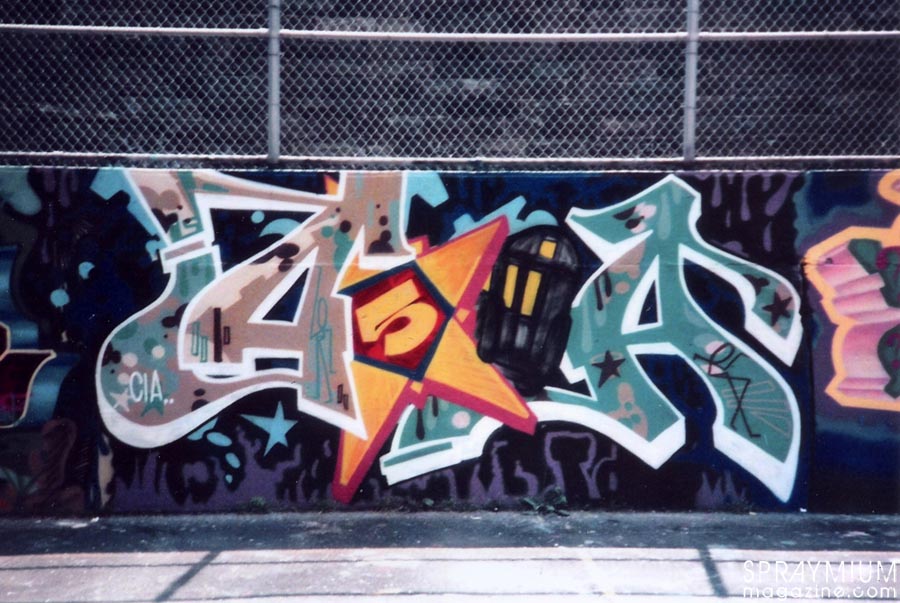
Asia (Doc) – NYC late 1990’s – « Cette pièce est un hommage à Dondi qui, n’étant pas disponible ce jour là, m’a demandé de le remplacer. C’était la première fois que je peignais au mythique Hall of Fame de la 106e avenue. »
De manière générale, comment Dondi considérait-il le graffiti ?
Pour lui, faire des graffitis était une façon pour un gamin invisible de se faire entendre. Chacun veut se faire entendre, chacun veut s’exprimer mais en réalité, tout le monde s’en fout. Si tu veux que l’on te considère, il faut être audacieux et extravagant. Les enfants des sixties ont été la première génération de gamins à se montrer et à se faire entendre. Mais la plupart n’ont pas su quoi faire de cette liberté d’expression et ont rapidement été réduits au silence par la société. Certains d’entre eux, silencieux le jour, se sont mis à hurler la nuit en écrivant leur nom sur les trains. On connaît la suite…
Quel héritage Dondi a-t-il laissé derrière lui ?
Son héritage se lit dans les lettres de son nom : Dévouement – Originalité – Nouveauté – Dynamisme – Intellect. Je n’ai jamais vu un artiste aussi brillant. À chaque fois que j’étais avec lui, je ne me sentais pas à la hauteur, mais il m’encourageait toujours. Il avait besoin de savoir que derrière lui, d’autre gamins sauraient se faire entendre.
Texte et interviews : Stéphanie Lemoine // Photos : Sophie Bramly, Martha Cooper, Henry Chalfant, Dondi, Nicolas Gzeley, Francisco Reyes, Mirame, Ghost Gallery // Un grand merci à Michael White et Doc TC5 pour leur précieuse aide.
English version
Twenty years ago, graffiti lost one of his generals : Donald White, better known as Dondi. Here is a come back to the life path of this prodigy, who left a deep mark on the graffiti and post-graffiti scene.
Five impeccable, tilted block letters, as if they had been thrown away by a wide open hand on the surface of a train. Five cursive, round letters, flanked by characters straight out of Vaughn Bode’s comics. Upon the mention of Dondi, the first images which come to mind are the wholecars of the series “Children of the grave” – a tribute to Black Sabbath’s heavy metal while hip hop was rising. He holds a good place in Henry Chalfant and Martha Cooper’s book Subway Art, with portraits of the artist in action, their photographic reproductions went round the world and their virtuosity never ceased inspiring generations of graffiti artists since the book was published in 1984. « With Subway Art, his graffitis have become iconic, confirms artist RCF1, who interviewed Dondi in 1992 during the exhibition Coming from the Subway at Groningen Museum. How many kids reproduced his drawings to understand how were the successions of letters organized ? We all dipped into some of his graffitis we saw in picture. »
The masterful pieces of “Children of the Grave” alone could not explain what caused Dondi to be called “style master general”. And one may have to seek the key to his legend beyond the several well-known clichés by which the artist conquered the planet. Because behind Dondi – a pet name his brothers gave him during childhood – lie a whole lot of pseudonyms. The artist from Brooklyn becomes in turn Bus, Pre, Asia, White, Roll, Pose… This abundance not only is a way to put the police off the scent, neither to be in keeping with his mates : varying the aliases makes it possible for him to explore all the potential of the alphabet, and push even further his mastering of the wildstyle. Art critic and curator from New York Carlo McCormick expressed how surprised he was to find out, in the archives of Henry Chalfant, that all those names on New York trains were actually from Dondi’s hand: « Sometimes he would use a name only once, he says, just in order to experiment. Whereas graffiti is often linked to a kind of advertising, he created new pseudonyms, in a permanent quest of style. »

Pose (Dondi), Duro – NYC 1982 – Photo : Henry Chalfant – « I love the P. The pump off the P isn’t a mistake. It holds it up. Dondi never explained how he did it, he would just say : What do you mean ? That’s the way it has to be. That’s the way it is. » (Doc)
According to DOC, member of TC5 crew and disciple of Dondi, such an approach is indicative of all masters : « Any writer whose goal is to master letter creation has to be able to create on high level every letter of the alphabet », he states. This quest proceed from a precise and exigent attention to the dynamics of the letters and of their succession. « My whole idea, my thing for style, was keeping the letters consistent, keeping them flowing, he explained to Zephyr on an interview in 1995, transcribed in the monograph Style Master General. When I looked at certain pieces, I would look for the flaw. It didn’t matter how it was outlined, or what the colors were, if the letter failed someplace then it failed, and then it was a flawed piece. » A method which DOC depicts in these terms : « Dondi’s approach to style would be considered Mechanical. It adheres to laws of physics and engineering. » Looking at his graffitis, one can notice how much he mastered the spray-paint can : « When one discovers graffiti, the first challenge is on how to control the tool (which is not designed for Fine Arts), and on how to avoid drips, reminds RCF1. Dondi has a “clean kid” side : the finish is conscientious, mastered, and there is virtuosity in how he draws the letters. »
Furthermore, this exigence goes largely beyond the scope of graffiti: the canvas, drawings and collages the artist has been dedicating himself to from the 1980s are also affected. « To me, he is the one who understood the best how to move from street to canvas, says gallery manager Valériane Mondot. He has one hell of a hand, and one hell of a conscience of what was a production in studio. I wonder what he would have become today. » In fact, unlike Futura who has a tendency for abstraction, and Rammellzee for whimsical journeys, Dondi created a personal style from the beginning, where lettering, mainly outlined in a sober, even sombre palette, mingles with a series of symbols – skulls, silhouettes, Latin inscriptions, stamps, etc. – full of his history and obsessions. « He had an instinctive conscience of painting, RCF1 tells. He knew intuitively that he should not paint a graffiti on a canvas. He had understood how important was the composition, and perceived that the energy of graffiti lies in spray-paint can – unlike others, who painted on canvas with a brush. »
As is often the case, the artist’s life story and personality explain his obligation to tread a path between the codes of the writing and the expectations of the gallery managers. Born in Manhattan in 1961 from intermarriage (his mother has Italian origins and his father is Afro-American), Donald White was the youngest of five brothers. « Dondi was quiet and introspective, his brother Michael says. The youngest son watched his older brothers to try not to repeat their mistakes. » He grew up like the kids of his age, raised pigeons, played Ringolevio (a street game which was popular in Brooklyn at the time), rode a bike. Only original fact : he attended a Catholic school, where – his father assumed – the education is better. This experiences he described as a happy one inspired him some leitmotivs of his canvas (vanity, the inscription “Anno Domini”), and certainly some of his behaviour traits – among which his rigour that is almost monastic and his inherent discretion. « He was very shy, recalls photographer Sophie Bramly, who rubbed shoulders with him in the early 1990s in New York, prior to playing an active role in spreading Hip Hop culture around Europe. He was the plain mama’s boy who studies in his room. He was not flamboyant like Zephyr, Futura or Fab5Freddy. » If his excursions in train depots and his stylistic audacity were not at variance with such an image, Dondi would look like a timid nature, not really fit for the virile, almost violent world of graffiti. « He was a soft spoken guy, kind of the quiet type but there was a thinker behind that quiet person and you could tell he was up to something », said artist Mark Bode, designer Vaughn Bode’s son. « He was in search of truth », claimed Patti Astor, who displayed his work at Fun gallery in 1982.
What is more, his personality might be what saved him. In the 1970s, the economic crisis signalled the decline of Brooklyn, and the arrival of gangs. Dondi confessed having rubbed shoulders with one of them, The Crazy Homicides. In fact he owed his oldest graffiti memories to their habit of writing on walls : « I got in graffiti on my own because as I’d go to different neighborhoods I was always looking on the walls to see what gangs was in the neighborhood, he recounts. That might have been a start. » His first steps in writing, in the middle of the 1970s were born out of the meeting of some people, like Duro, who became his best friend and one of his most zealous mates. With him, Dondi joined the TOP crew (The Odd Partners) – which was a past master of throw-ups on BMT trains (Brooklyn Manhattan Transit) – and firstly manifested his predilection for graffitis inside trains. At that time, the foundations of writing are laid. The second and third generation of writers then worked on enhancing what their elders had invented. By spending hours shaping his letters in his sketchbooks and pushing away the limits of style under the trains’ windows, Dondi started getting up as a bomber. Then came the first whole cars : « when I was doing whole-cars, I was just doing whole-cars because they were fun, he said. It was the next step for me. (…) Coming from the bomber mentality, you know, doing blockbusters, developing style, starting to bend letters, throw arrows, do wild styles, and soon that was the only other thing to do. »
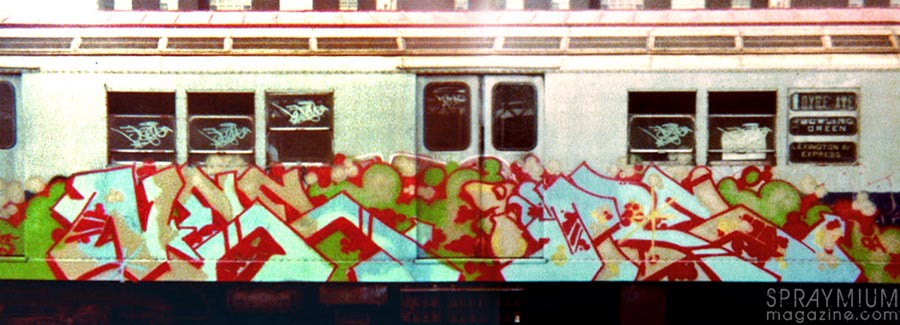
Nee, Pre (Dondi) – NYC 1980 – Photo : Dondi – « I remember calling Nee’s card on this because he was bragging. And i told him that Dondi had done the outline and he painted. Nee maybe filled it in, but he was basically a look-out. » (Kel)
As we saw, for Dondi, graffiti is primarily a matter of style. According to some of his declarations, the codes of conduct of the field left him rather indifferent. « I wasn’t into racking up or anything », he stated for instance. « His practice was illegal, but he does not have the attitude », Carlo McCormick confirmed. Neither was he reluctant to the digestion of graffiti by art galleries, like some writers were in the early 1980s. With Fab5Freddy, Zephyr and Futura, the young man met the artistic bohemian lifestyle of downtown, participated in the first collective exhibitions of graffiti, and used to attend the studio which Sam Esses – a businessman and a collector – provided to some hand-picked writers. In 1982, Patti Astor’s Fun gallery dedicated him a solo show. « Moving into the gallery, I had a whole other audience I had to communicate with which was good, because it made my work evolve », he told. At the same time, he collaborated with Charlie Ahearn on the movie Wild Style. « He stood in for Lee in the action scenes shot in train depots », recounts Patti Astor. He also created the image of Zoro (main character of the film played by Lee, ed.), a fantasized representation of the hero. Moving towards a studio production seemed to be logically aligned with his history : no doubt that it was “the next thing to do”, to take the expression of his talent and singularity one step further. « I was never a graffiti writer artist, even when I was active in the subway yards. I was a subway painter. A subway writer. Now that I do work on canvas, my work consists of “high tech letters with ghetto based images” (they are not graffiti painting). If you must title my work it can only go under one title: “Dondism”. »
Yet, the artist had a lot of trouble freeing himself from the labels slapped on his work: for most of the New York traders, he will remain another Brooklyn kid that made graffiti. In the 1980s, he followed the classic course of the writers of his generation : while the trend was about to fade in the galleries and the MTA went out of their way to prevent graffiti on trains, he discovered Europe with the New York City Rap Tour and the Dutch gallerist Yaki Kornblit. There, he found his most devoted and faithful audience. One example is the exhibition Coming from the Subway, in which he participated in 1992 at Groningen Museum. « He often mentions his career as similar to American Jazz Music. A not taught, not supervised artistic expression that the Europeans embraced and understood first. » But unlike other artists, Dondi stayed in the US. At the end of the 1980s, he took distance from the art market, even if he still participated in a handful of events and exhibitions. That does not mean he did not create anymore, but he opted for collage, which enabled him to continue his plastic searches independently and work at his own pace, without any pressure. From 1993, he tried his hand at photography and hunted what remains unexpected, invisible, walking and cycling in the streets of New York. Sadly, fate did not let him enough time to continue for a long time in this direction: « I think Dondi was diagnosed with HIV/AIDS fall of 1995. Fall of 1997 full blown AIDS. He came to terms with his illness, made his end of life decisions. He lived his last year of life on those decisions, that were honored by family, friends. He passed away quietly at home 2 Oct 1998 surrounded by family and friends. »
As no one is a prophet in his own land, and old school graffiti even less, it is in France that the 20th birthday of his passing will be commemorated. « A way of giving back to Europe what Europe gave him », suggests co-director of the Ghost gallery of Marseille Caroline Pozzo. From April 7th (Dondi’s day of birth), this new venue of urban art will open its doors dedicating the artist a vast retrospective, of which Michael White is the curator. Around fifty canvas, drawings and collages gathered from European collectors, plus photographies and different documents: « We want both to transpose the universe of Dondi and to do something very intimate », tells the gallery manager. For the occasion, there will be no sales. This is a remarkable fact because since a few years, the collectors seem to rhapsodise about the artist: « Dondi had been put aside for a long time, Valérina Mondot said. People recognized his importance but the market was not following. Fifteen years ago, when I advised my collectors to buy his works, they would say “who is that man ?”. Today, everybody wants some, everybody is looking for some. There is an effusion. This success is justified, except Dondi is dead and we never speculate on a dead artist. »
To this day, the Ghost gallery exhibition is yet the only official commemoration of the artist. But who knows what is happening behind the scene, in the secrecy of the black books, the wastelands and the train depots. « I hope the rest of activities happen on their own, Michael White says, paint, create, give to charity, tell your story of how Dondi’s life and work impacted you. »
DOC TC5 « The disciple »
During the early to mid 1980’s, Doc TC5 consistently set the bar a bit higher than most other writer could reach. Under the careful tutelage of stylemaster Dondi, Doc praticed the tradition of mecanical letterforms, and as an apprentice to character king Doze, he picked up a fine B.Boy style. Under many different names (Arab, T.Spoon, Pull, Wire, Wave, Supreme…), Doc TC5 keeps alive Dondi’s legacy.
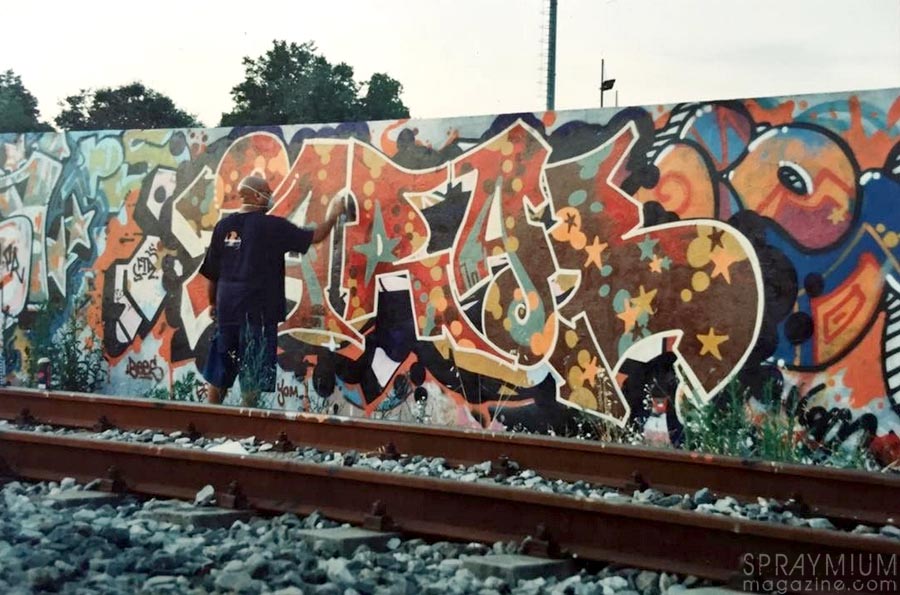
Arab (Doc) – Italy 1990’s – « Master At Work series #5 getting busy on the railroad tracks in Firenze, Italy once upon a time in the 90’s. Thanks to my boys Smart, Ens and Bees P.R.-Cru. »
How and when did you meet Dondi and start painting with him ?
I met Dondi for the first time in 1979. Many times after that i would run into him at different events. He never really remembered me for the same reasons rock stars don’t remember their fans. I hadn’t made my mark in the world of graffiti at that time so i was viewed as another writer in a sea of many. It wasn’t until 1983 when i noticed Dondi’s phone number in the phone book of another artist named Doze, i convinced him to call Dondi and he wound up inviting us over… we became instant friends.
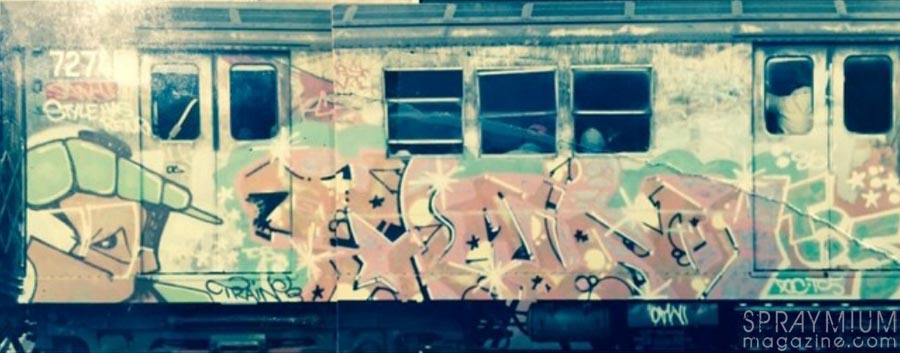
Train (Doc) – NYC 1988 – « A little throwback funk from the 1 tunnel, from your friendly neighborhood « Styler Man » – Train piece on a train. Half of the Train-Yard car painted with Web. »
For how long were you involved in writing ?
I had always been into graffiti, taking my first train tag in 1978. My most prolific and notable work was done with the TC5 crew aka The Cool 5.
Which was your relation to Dondi ?
My relation to Dondi was student and close friend.
Which was your “modus operandi” when you painted with Dondi ?
My MO was always DOC but Dondi and myself didn’t paint much publicly because he had retired from graffiti (Train Painting) in the early 80’s.
You are from Brooklyn too. Which were your relations with writers from other neighborhoods ?
Yes im from Brooklyn, I lived a short distance from Dondi. Back then most people were leery about traveling to other Burroughs. Only the adventurous traveled around the city to meet other artist. I was always made a point of hanging out with artist from other parts of the city. It was easy for me since i went to high school in Manhattan.
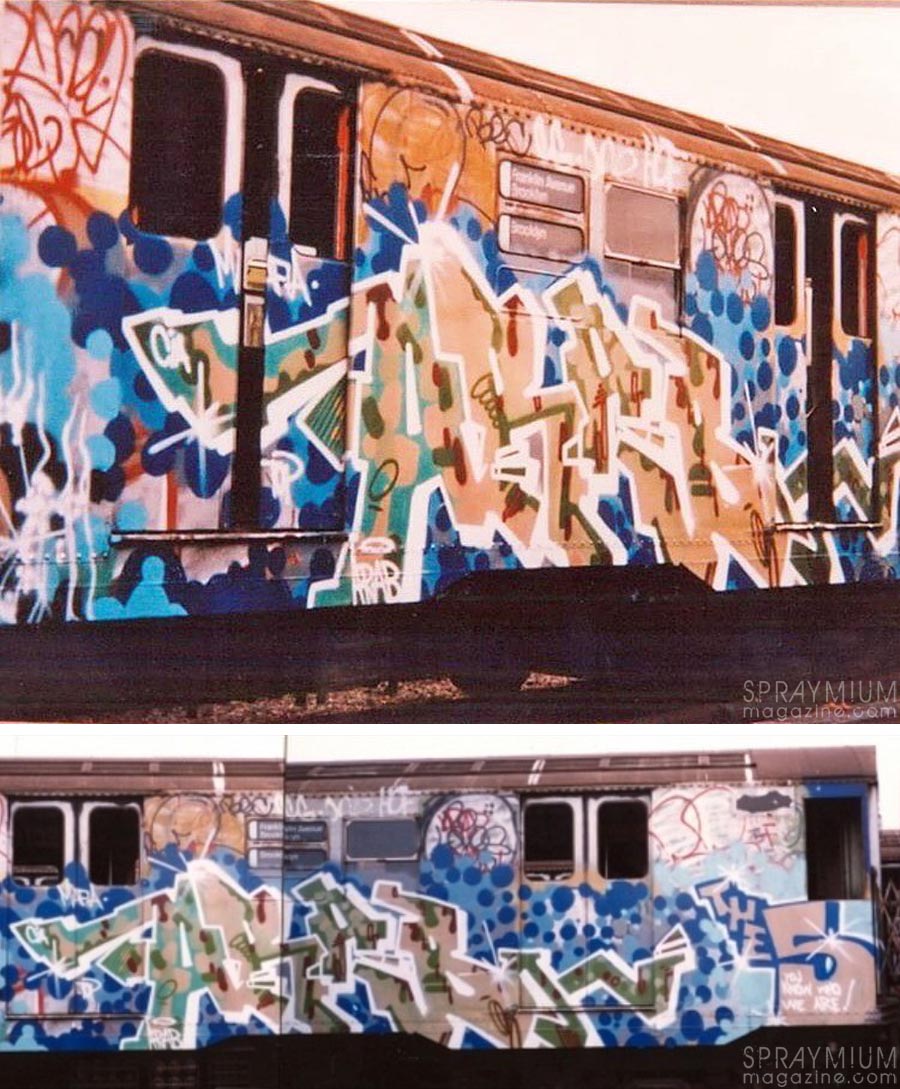
Arab (Doc) – NYC 1988 – « Painted with Magoo2 on the BMT’s with remnants of Supreme Quality and Krylon. »
The spraycans evolved a lot. How were they challenging back then ?
Spray cans have evolved immensely. In my time using spray paint was like painting with a grenade. Old school paint had very high pressure compared to todays paint. It used to take about three years to paint proficiently with high pressure paint. Today’s low pressure paint is so easy to use a novice can master its use in a month or two.
You and Dondi had several names.
Yes Dondi and myself had many names, but that is indicative of all masters. Any writer whose goal is to master letter creation has to be able to create on high level every letter of the alphabet. Dondi’s most famous aliases were Bus129, Asia, Pre2 and Mr. White. My aliases were Arab, Major Pull and Supreme. Quite often i would formulate my names to coincide with Dondi’s names so that if he came out of retirement i would be ready to paint with a complementary name. All masters had multiple names and for many reasons. Originally it was because of the police, famous writers were pursued by the police. If a famous writer was captured it would scare up and coming vandals, so famous writers sometimes changed their names when they painted on different train lines or if the Vandal Squad was getting close. Also in the 70’s masters would start trends by picking a new name starting with a “W” or “P” and many would follow suit… the “Death Squad” was famous for this.
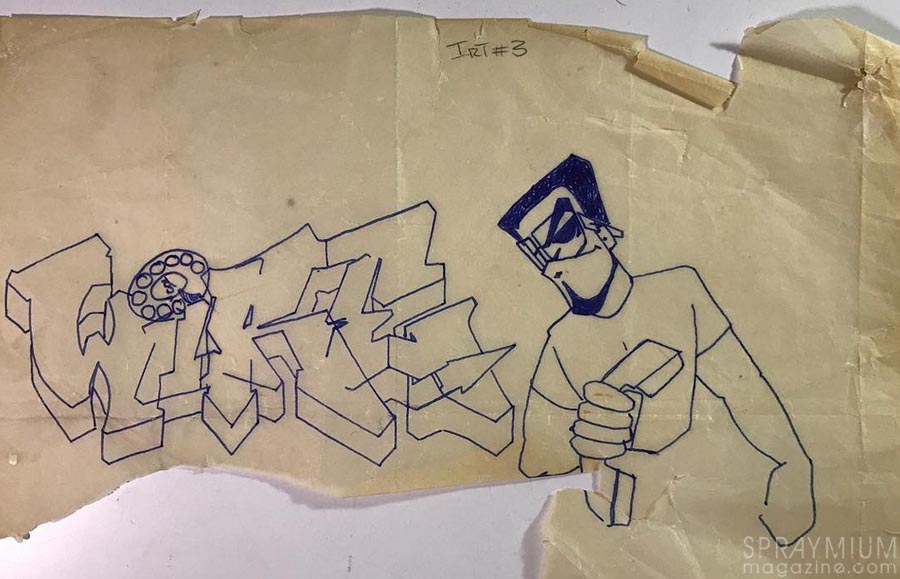
Wire (Doc) – « This is the Physical Outline I took to the yard when me and Web painted the Dial Tone x Live Wire car on the 3’s. This car was painted in New Lots back in the 80’s. »
Dondi was a big fan of Vaughn Bodé.
Yes Dondi was very fond of Vaughn Bodé’s work but so was everyone. His characters spoke to graffiti writers like nothing before. It felt like Bodé’s creations were designed to be paired with graffiti pieces more so than any other cartoon characters ever created.
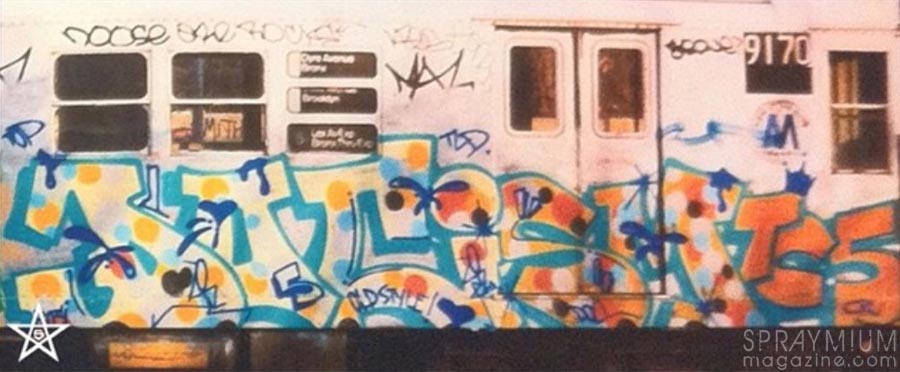
Docism – NYC 1980’s – « Scrap can quickie at the end of a Seensation. Seen had left a lot of space next to his piece so I dropped this in to keep the throw-up kids from wrecking the car. This was an educated throwie. Fill in wise you could say it was inspired by SEEN-TC5. »
In Europe where I live, Dondi is mainly identified with the serie “Children of the grave”. Do you feel it in a way gave a wrong idea of his style ?
As far as Europe is concerned it was a combination of “Subway Art” the book and the “Wild Style” tour that made Dondi an icon, but it was so much more than that. He was physically prepared for the big time when he visited Europe on the “Wild Style” tour. He had shifted his talents from the trains and made himself gallery ready. While most of the great artist of his time were still toiling in underground tunnels his focused shifted to moving above ground. He was completely ready for the fine art worlds soon to be lust for what would soon to become Hip-Hop Culture. Actually Dondi is not mainly recognized for his “Children Of The Grave” series. In America he is more famous for his approach to style and his precision. I think the “COTG” series was more popular over seas because the fans there are more into concepts.
Dondi didn’t only paint on trains, but also on canvases, and stepped into collage. How do you consider this evolution ?
Dondi’s evolution from trains to canvas and collage were far from random. Every step of his career was well thought out and possibly motivated by his mastery level… in other words he bored easily and was always looking for the next challenge. When the artist of his era were focusing on becoming greater train painters, Dondi was already on his 3rd series of canvases constantly progressing and getting better even though there wasn’t a gallery scene that was ready for his work on Canvas. When graffiti on canvas became all the rage and the market started to water down he moved on to collage drawings, always staying unique and one step ahead… I always wonder if he was still alive what new levels he would have taken graffiti to.
It seems that painting “graffiti” on canvases was not at that time regarded positively by all writers, and that there were strong debates about it inside the graffiti world. Do you agree ?
Yes there were many arguments against graffiti on canvas and it was frowned upon by many famous artist of the time. The only problem is that graffiti writers are notorious for having tunnel vision when it came to the future of the art form. Most of us thought that Graffiti on subway cars would last forever, we thought it would never end ! We were totally blind sided when NYC put an end to Subway Art. That’s why the few artist who had the the vision to take this giant sized art form and adapt it to canvas wound up at the top of the heap.
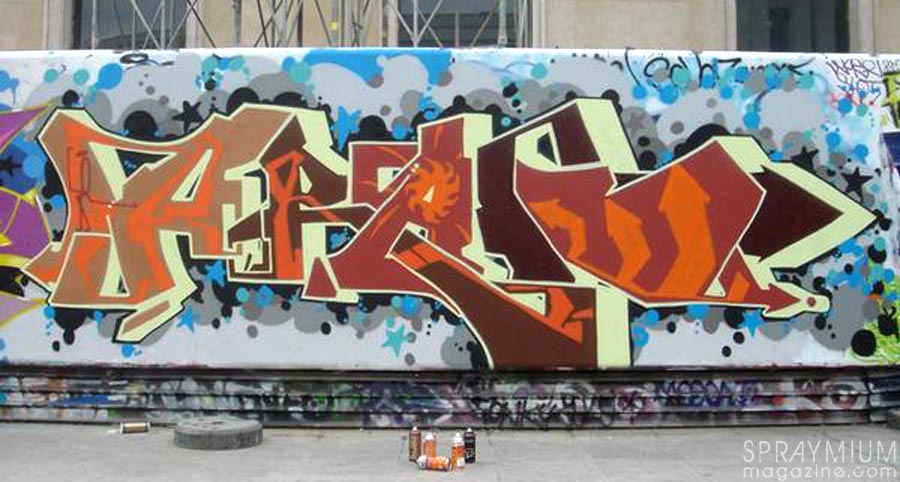
Arab (Doc) – Paris 2005 – « I painted this piece at the « Palais de Tokyo » in Paris, France. I freestyled this off the dome to challenge myself. This was a giant canvas stretched on a gate, about a half a block long that they allowed anyone to paint. Unfortunately the minute you finished another artist would go over you before you finished packing your bags. I still remember a group of guys waiting patiently to go over us. First they were upset and anxious that we were putting so much time into our pieces, then all of a sudden they realized something special was happening and that they were bearing witnesses to something historical. By the end they were awe struck because it became clear that they stumbled upon a Mastery Lesson… and Class was in Session. When we finished we ascended to the upper level of the promenade to privately admire our work and to unceremoniously kiss it goodbye… when all of a sudden one of the spectators stepped to my piece can in hand, ready to sketch over my masterpiece. I waited, holding my breath for him to paint his first stroke, can raised, hand in motion prepared for the worst and closed my eyes. When I opened them… nothing! my masterpiece was still intact. The taggers in my opinion saw the value in what was created in front of them that day and decided to break from the norm and let our pieces live. We walked away feeling accomplished knowing that we made a difference in this graffiti continuum… »
More generally, how did Dondi considered writing ?
Writing graffiti to Dondi was the way for an invisible child to be heard. Everyone wants to be heard, everyone needs to express themselves but the reality is no one cares. In order to be heard in this world you often have to do something bold or outrageous. The children of the 60’s was the first generation in history where the children were seen and heard… but most children did not know what to do with this new found freedom of expression and were quickly silenced by society. A few of these children although silenced by day found that they could scream out loud at night by entering tunnels and writing their names on the side of trains… and the rest is history.
Which is Dondi’s legacy in the writing culture ?
Dondi’s legacy to the culture will be expressed through the letters of his name Dedication-Originality-Next(level)-Dynamic and Intellectual. I never saw an artist whose light shone as bright as his. Every time I thought I caught up to him he graciously dropped the hammer and let me know he still was the undisputed… but he never discouraged me from trying. I knew he wouldn’t be able to retire from the graffiti world without some level of angst if he didn’t have a hand picked representative from the planet of brooklyn to continue the legacy… of silent children that need to be heard.
Text : Stéphanie Lemoine // Photos : Sophie Bramly, Martha Cooper, Henry Chalfant, Dondi, Nicolas Gzeley, Francisco Reyes, Mirame, Ghost Gallery // Many thanks to Michael White and Doc TC5 for their precious help.
